new posts in all blogs
Viewing: Blog Posts Tagged with: bio, Most Recent at Top [Help]
Results 1 - 25 of 44
How to use this Page
You are viewing the most recent posts tagged with the words: bio in the JacketFlap blog reader. What is a tag? Think of a tag as a keyword or category label. Tags can both help you find posts on JacketFlap.com as well as provide an easy way for you to "remember" and classify posts for later recall. Try adding a tag yourself by clicking "Add a tag" below a post's header. Scroll down through the list of Recent Posts in the left column and click on a post title that sounds interesting. You can view all posts from a specific blog by clicking the Blog name in the right column, or you can click a 'More Posts from this Blog' link in any individual post.

By: Shelf-employed,
on 11/9/2015
Blog:
Shelf-employed
(
Login to Add to MyJacketFlap)
JacketFlap tags:
YA,
nonfiction,
Civil War,
J,
Non-Fiction Monday,
spies,
bio,
Allan Pinkerton,
digital audiobook,
Add a tag
Today I'm happy to share in the celebration for the publication of
Fab Four Friends: The Boys Who Became the Beatles, written by
Susanna Reich, illustrated by
Adam Gustavson, and published by Macmillan.
Author Susanna Reich has written an inspiring book chronicling the early years of John, Paul, George, and Ringo. Each is highlighted in turn with a focus on the events and people that shaped his future and his interest in music.
The final pages feature the band's early successes. Readers will be impressed by the boys' dedication to their musicianship and their ability to overcome family tragedy, illness, and in John Lennon's case - a lack of musical training and a guitar that his mother taught him to tune like a banjo.
John attacked the guitar, strumming as fast he could. He didn't give a fig about wrong notes.
Eventually Paul traded in his trumpet for a guitar. From then on, his brother said, "he didn't have time to eat or think about anything else."
At school, George sat in the back and drew pictures of guitars. But when it came to practicing, no one was more serious.
Back home, Richy [Ringo] couldn't stop his hands from tapping. Listening to all kinds of music—country and western, jazz, blues, skiffle—he'd rap on the back of a chair, bang on a box, or pound an old bass drum with a piece of firewood.
The text is small and in simple font on a plain background, leaving ample room for Adam Gustavson's stellar illustrations in "oil paint on prepared paper." It is a difficult task to render likenesses of these four men who are known and revered the world over. Gustavson has done a remarkable job in capturing their youth, signature expressions, and intensity of mood. In quiet acknowledgement of the post-war era that engendered the rise of rock and roll, the book opens with double-spread illustration of "a dark October night in 1940," the night when John Lennon was born in the midst of war with Germany. The final double-spread is the one that appears on the book's jacket.
More illustrations from Fab Four Friends are on the publisher's site.Rounding out
Fab Four Friends are an Author's Note, Glossary
(I'm sad that phonograph needs to be in the glossary!), Notes, and Sources.
I asked only one interview question of author Susanna Reich. With so many songs to choose from and her obvious love of her topic, I knew it would be a tricky question:
Q: "What's your favorite Beatles tune?" It sent her to her headphones for an hour of listening. Her final answer:
A: "Let it Be."It's certainly hard to argue with that.
The publisher's site lists a suggested age range of 6-10. I think older kids, particularly those with musical inclinations will be interested in this one as well.
Note:
A book's case and jacket are often (usually) the same. Library books are typically processed with protective coating on the jacket that secures it to the cover. So, if you're a librarian, or a library user, you may never see the books' case. If possible, however, take a peek under the jacket of
Fab Four Friends. The front cover features individual portrait style paintings of Paul, John, George, and Ringo. They appear youthful and suited and are presented in square frames reminiscent of yearbook photos or 1970s era Beatles posters. They are joyful and boyish - four fab friends.
My copy of
Fab Four Friends was provided by the publisher. You can find yours on a library or bookstore shelf, beginning today, August 18, 2015.
Follow the blog tour for
Fab Four Friends: The Boys Who Became the Beatles. Tomorrow, the tour will stop at
UnleashingReaders.com .
Happy book birthday to Fab Four Friends!

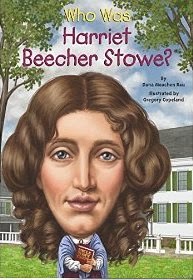 I have to admit, that Who Was Harriet Beecher Stowe? is the first I've read in the Who Was ... ? series. When I first began receiving them a year or so ago, I thought that kids would be turned off by the caricature cover art. I was wrong. They have been quite popular for biography assignments. One reason is because Grosset & Dunlap (Penguin) was smart enough to make them each about 100 pages long. (Teachers, I do wish you would be less strict with page counts, particularly in nonfiction. Kids miss out on a lot of great books because they're trying to reach that magic number.)
I have to admit, that Who Was Harriet Beecher Stowe? is the first I've read in the Who Was ... ? series. When I first began receiving them a year or so ago, I thought that kids would be turned off by the caricature cover art. I was wrong. They have been quite popular for biography assignments. One reason is because Grosset & Dunlap (Penguin) was smart enough to make them each about 100 pages long. (Teachers, I do wish you would be less strict with page counts, particularly in nonfiction. Kids miss out on a lot of great books because they're trying to reach that magic number.)
In any case, I am pleased to see that the latest entry into the Who Was? series is writer Harriet Beecher Stowe, best known for her book Uncle Tom's Cabin, or for being, as President Lincoln said, "the little woman who wrote the book that made this great war."
Rau, Dana Meachen. 2015. Who Was Harriet Beecher Stowe? New York: Grosset & Dunlap.
The first chapter bears the title of the book, "Who Was Harriet Beecher Stowe?" and gives a very brief synopsis of her life and its impact on history. Other chapters elaborate on her personal life and her book, Uncle Tom's Cabin. Today's young readers should find it fascinating that in an age before telephones, radios, televisions and computers, the publication of this one book made Harriet Beecher Stowe a wealthy and well-known celebrity in the U.S. and Europe, and it helped bring about the end of slavery by changing public opinion.
The book is illustrated with black and white drawings, and also contains several double-spread illustrations featuring background information that is necessary to gain an understanding of the era. These inset illustrations explain The Famous Beecher Family, The Underground Railroad, The Congregational Church, and Frederick Douglass.
The story of Harriet Beecher Stowe is a perfect illustration of the power of the pen. Hopefully, it will inspire young readers to seek out a copy of Uncle Tom's Cabin in the future.
Rounding out the book are time lines and a bibliography.
Who Was Harriet Beecher Stowe? will be on a shelf near you on 4/21/15. My copy was provided by the publisher.

.jpg) Barton, Chris. 2015. The Amazing Age of John Roy Lynch. Grand Rapids, MI: Eerdmans. Illustrated by Don Tate.
Barton, Chris. 2015. The Amazing Age of John Roy Lynch. Grand Rapids, MI: Eerdmans. Illustrated by Don Tate.
The Amazing Age of John Roy Lynch is a nonfiction picture book for school-age readers and listeners. More than just an inspirational story of a former slave who becomes a landholder, judge, and United States Congressman, it is a story that focuses on the great possibilities presented during the period of Reconstruction.
"In 1868 the U.S. government appointed a young Yankee general as a governor of Mississippi. The whites who had been in charge were swept out of office. By river and by railroad, John Roy traveled to Jackson to hand Governor Ames a list of names to fill those positions in Natchez. After John Roy spoke grandly of each man's merits, the governor added another name to the list: John Roy Lynch, Justice of the Peace.
Justice. Peace. Black people saw reason to believe that these were now available to them. Just twenty-one, John Roy doubted that he could meet all those expectations. But he dove in and learned the law as fast as he could."
Sadly, the reason that John Roy Lynch's story is amazing to today's reader is because the opportunities that abounded during Reconstruction dried up and disappeared as quickly as they had come. The period of hope and optimism for African Americans in the years from 1865 to 1877, gets scant attention today. The life of John Roy Lynch is an excellent lens through which to view Reconstruction.
To make sometimes difficult scenes accessible to younger readers, Don Tate employs a self-described, "naive ... even whimsical" style. It works well with the sepia-tinged hues that help to set the time frame.
The Amazing Age of John Roy Lynch is a powerful, historical reminder of what was, what might have been, and what is.
A Timeline, Historical Note, Author's Note, Illustrator's Note, For Further Reading, and maps round out the book.
Advance Reader Copy provided by


By: Shelf-employed,
on 2/13/2015
Blog:
Shelf-employed
(
Login to Add to MyJacketFlap)
JacketFlap tags:
space,
scientists,
astronomy,
picture books for older readers,
bio,
E,
STEM,
Carl Sagan,
STEM Friday,
book review,
science,
Add a tag
Sisson, Stephanie Roth. 2014. Star Stuff: Carl Sagan and the mysteries of the cosmos. New York: Roaring Brook.
In simple text augmented by word bubbles, thought bubbles, and sketches, Stephanie Roth Sisson gives us the highlights of Carl Sagan's life
—but more importantly, she offers a sense of his wondrous enthusiasm for the cosmos,
It gave Carl goose bumps to think about what he had learned about the stars, planets, and the beginnings of life. He wanted everyone to understand so that they could feel like a part of the stars as he did.
So he went on television.
This is the first book that Stephanie Roth Sisson has both written and illustrated. The fact that she is enthralled with her subject is apparent in the artwork. Painted cartoon images (often in panels with word bubbles), depict a happy Sagan, wide-eyed and curious. While some pages are like panel comics, others are full-bleed, double spreads depicting the vastness of the darkened skies, dotted by planets or stars. One foldout opens vertically, reminding us of our infinitesimal existence in the cosmos. We are so small, yet we are reminded,
The Earth and every living thing are made of star stuff.
Star Stuff is a 2015
NCTE Orbis Pictus Award Honor book for "outstanding nonfiction for children."
Substantial back matter includes Author's Note, Notes, Bibliography and Sources, Special Thanks, and Source Notes.
Preview the first eight pages of Star Stuff on the publisher's website.Note: Carl Sagan graduated from Rahway High School in Rahway, NJ. As far as I can tell, he's not mentioned anywhere on the school's website. Pity.
It's STEM Friday! (STEM is Science, Technology, Engineering, and Mathematics)


By: Kathy Temean,
on 12/20/2014
Blog:
Writing and Illustrating
(
Login to Add to MyJacketFlap)
JacketFlap tags:
Process,
submissions,
revisions,
article,
authors and illustrators,
bio,
Melissa Iwai,
Bebe Willoughy,
inspiration,
Advice,
Add a tag

This sweet illustration was sent in my Melissa Iwai. Melissa was featured on Illustrator Saturday.
When I meet a new writer and they ask me for advice, I always point out not to rush to submit what they have written. That advice comes from personal experience and many years of observation. When you are new you think everything you write is wonderful and it isn’t until a few years late and many rejections that you realize you better get into a critique group and learn to revise. The trouble is a writer can go on too long with revisions and setting things aside, so when Bebe sent me this short article I thought it might provide the inspiration you can use going into 2015.
Here’s Bebe:
 Listening Too much or Self Doubt
Listening Too much or Self Doubt
By Bebe Willoughby
While people who worked in publishing above us hurried off to the Hamptons on Friday’s early summer dismissal, a co-worker and I stayed in the air conditioned office to write a book on dreams. Our lack of self-confidence prevented us from sending it out.
We tucked the manuscript safely in a drawer , where it stayed for four years. We joined a writing group and brought along the manuscript. The leader, a well-known writer/ illustrator, said it was publishable and encouraged us to send it out. So we did and got a quick call from an editor who wanted to publish it.
I have another tale to tell that involves doubting myself and listening to far too many people. I wrote a short story entitled “Nothing Lasts Forever.” None of my writer friends showed much enthusiasm, and a top editor told me I did not write well enough for major magazines. I lived with that declaration for quite some time. Then a friend who did not work in publishing advised: “send it out. You have nothing to lose.” She, of course, was right, but I had not seen it that way. My tale has a happy ending. The story was published in Seventeen magazine.
I encourage writers to have others read their work, but be careful about listening too hard. In the end, you must trust yourself.
Bebe Willoughby earned a M.F.A.in creative writing at Columbia University and is the author of five works of fiction–four children and one novel for adults. She served for ten years as an editor at Random House.
Bebe, thank you for sharing your experiences with all of us. I hope it inspires everyone to get their revisions done and submit more of their writing and illustrating this year. Remember, it doesn’t always have to be a book contract to be successful. Wishing everyone a very successful 2015. Now’s the time to start think laying out a plan.
Talk tomorrow,
Kathy
Filed under:
Advice,
article,
authors and illustrators,
bio,
inspiration,
Process,
revisions,
submissions Tagged:
Bebe Willoughy,
Melissa Iwai 


By: Shelf-employed,
on 10/27/2014
Blog:
Shelf-employed
(
Login to Add to MyJacketFlap)
JacketFlap tags:
poetry,
memoir,
nonfiction,
writing,
religion,
New York,
family life,
Civil Rights,
J,
novels in verse,
1960s,
Non-Fiction Monday,
South Carolina,
bio,
African Americans,
Add a tag
 Woodson, Jacqueline. 2014. Brown Girl Dreaming. New York: Penguin.
Woodson, Jacqueline. 2014. Brown Girl Dreaming. New York: Penguin.
Despite the title, Brown Girl Dreaming is most certainly not just a book for brown girls or girls. Jacqueline Woodson's memoir-in-verse relates her journey to discover her passion for writing. Her story is framed by her large, loving family within the confines of the turbulent Civil Rights Era.
Sometimes a book is so well-received, so popular, that it seems that enough has been said (and said well); anything else would just be noise. Rather than add another Brown Girl Dreaming review to the hundreds of glowing ones already in print and cyberspace, I offer you links to other sites, interviews and reviews related to Brown Girl Dreaming. And, I'll pose a question on memoirs in children's literature.
First, the links:
And now something to ponder:
As a librarian who often helps students in choosing books for school assignments, I have written many times about the
dreaded biography assignment - excessive page requirements, narrow specifications, etc.
Obviously, a best choice for a children's book is one written by a noted children's author. Sadly, many (by no means
all!) biographies are formula-driven, series-type books that are not nearly as engaging as ones written by the best authors. Rare is the author of young people's literature who writes an
autobiography for children as Ms. Woodson has done. When such books exist, they are usually memoirs focusing only on the author's childhood years. This is perfectly appropriate because the reader can relate to that specified period of a person's lifetime. Jon Sciezska wrote one of my favorite memoirs for children,
Knucklehead, and Gary Paulsen's,
How Angel Peterson Got his Name also comes to mind as a stellar example. These books, however, don't often fit the formula required to answer common student assignment questions, i.e., birth, schooling, employment, marriages, accomplishments, children, death. Students are reluctant to choose a book that will leave them with a blank space(s) on an assignment.
I wonder what teachers, other librarians and parents think about this. Must the biography assignment be a traditional biography, or can a memoir (be it in verse, prose, or graphic format) be just as acceptable? I hate to see students turn away from a great book because it doesn't fit the mold. If we want students to be critical thinkers, it's time to think outside the box and make room for a more varied, more diverse selection of books.


By: Kathy Temean,
on 10/10/2014
Blog:
Writing and Illustrating
(
Login to Add to MyJacketFlap)
JacketFlap tags:
inspiration,
Advice,
Process,
illustrating,
How to,
bio,
demystify,
Illustrator's Saturday,
Anna Guillotte,
Interview,
Add a tag
 Anna Guillotte is an American illustrator, designer, and writer living in Heidelberg, Germany. With a degree in graphic design, Anna worked as a graphic artist in the corporate world for seven years. Though she was also a mural artist and painter throughout that time, she began illustrating in 2010 when she attended a mentor program for artists in San Diego, California where she lived at the time. Through this program she realized her true calling for storytelling. She has since joined the SCBWI, attended numerous SCBWI conferences and her illustrations have been published internationally. She enjoys creating whimsical, funny, touching, and beautiful art for the advertising, book, and animation markets.
Anna Guillotte is an American illustrator, designer, and writer living in Heidelberg, Germany. With a degree in graphic design, Anna worked as a graphic artist in the corporate world for seven years. Though she was also a mural artist and painter throughout that time, she began illustrating in 2010 when she attended a mentor program for artists in San Diego, California where she lived at the time. Through this program she realized her true calling for storytelling. She has since joined the SCBWI, attended numerous SCBWI conferences and her illustrations have been published internationally. She enjoys creating whimsical, funny, touching, and beautiful art for the advertising, book, and animation markets.
Here is Anna showing one of her techniques:
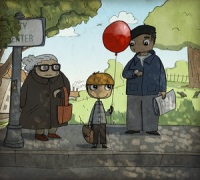 There’s something about light and shadows that really soothes the eye. I guess I could do research on the scientific reason as to why us humans are attracted to depth in images, but I already spend too much time on the net. I’m guessing since that we live in a 3-dimensional world our eyes are built to receive and digest lovely indications of depth (i.e. shadows, light vs. dark, cool vs. warm colors) and by nature we crave that. I tend to indulge in lighting my illustrations so I thought I would share how I go about doing that – from sketch to finished image.
There’s something about light and shadows that really soothes the eye. I guess I could do research on the scientific reason as to why us humans are attracted to depth in images, but I already spend too much time on the net. I’m guessing since that we live in a 3-dimensional world our eyes are built to receive and digest lovely indications of depth (i.e. shadows, light vs. dark, cool vs. warm colors) and by nature we crave that. I tend to indulge in lighting my illustrations so I thought I would share how I go about doing that – from sketch to finished image.
The key here is to make the scene believable, even if it’s not 100% accurate. So I guess in a sense you become a car salesman convincing a customer that not only is the Hyundai Elantra a great car, but the most awesome car you will ever buy in your life.
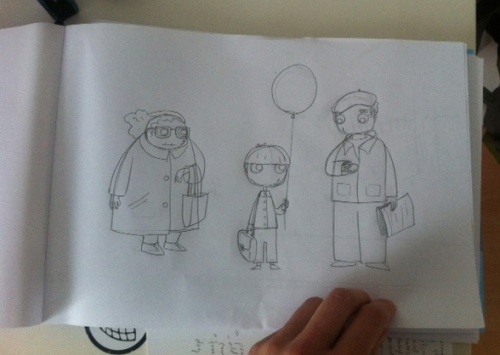
I start with a hand-drawn sketch. Why not go digital? Eh, the tablet doesn’t feel right and I guess I need to feel paper and pencils in my hand. I then scan the drawings in Photoshop.
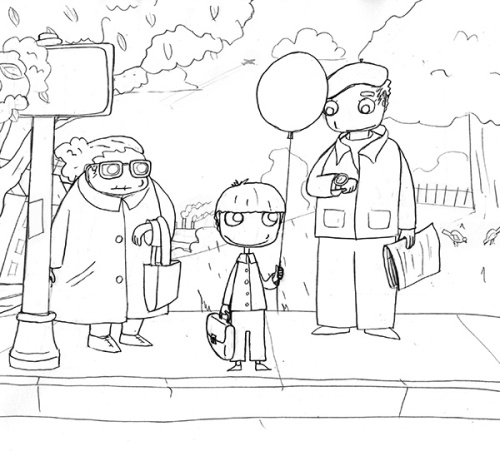
In Photoshop I clean up the images and create separate layers for the different visual elements. This allows for more control over placement, size, coloring, and opacity. For example, in the image below I have a layer for each character, the background, and several additional details I added in later (the plane, smokestacks, birds, fence, and sticker on signpost). Keep in mind that all the coloring layers are in the “multiply” blend mode – and the texture layers are in “color burn” and “overlay” blend mode. I suggest playing around with those settings and see what you come up with : )
Here is a video tutorial on How to use Blending mode in Photoshop CC.
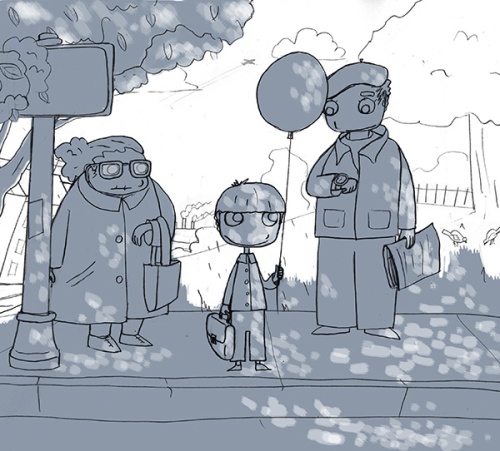
Now I block in the foreground shade. I imagined this bus stop scene taking place under a large tree. And as we have all observed – shade from trees are not one massive blob, but a shadow dance of many, many leaves. I made a layer of a dark blue and masked it out. Then I removed bit by bit the “shadow dance” until I thought it was convincing. Sometimes I consult with Google Images to make sure the lighting is believable.
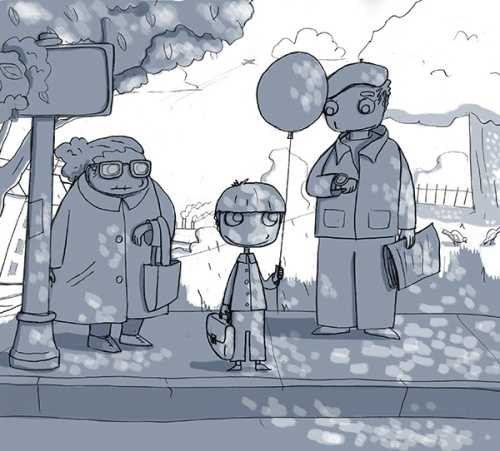
I added additional shadowing on a separate layer.
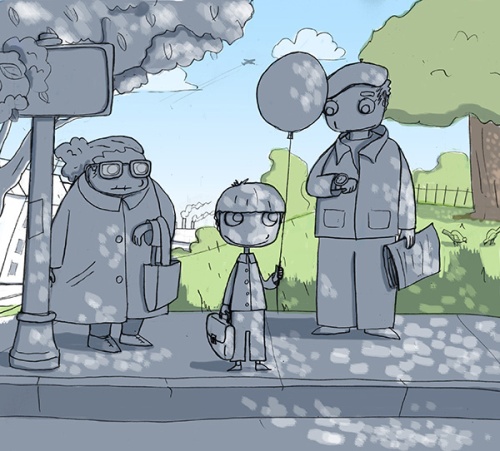
And now the color! We begin with the background color. The blue sky on a separate layer from the tree/grass.
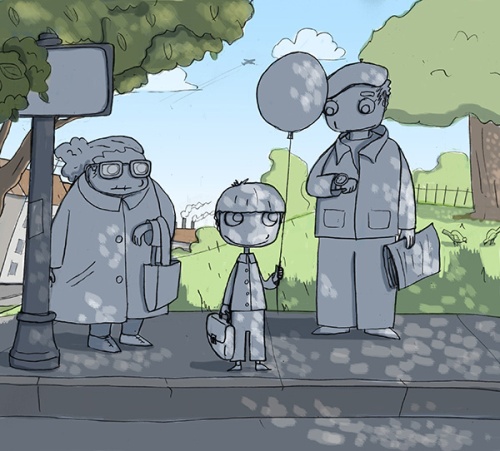
Another layer is added for the foreground objects.
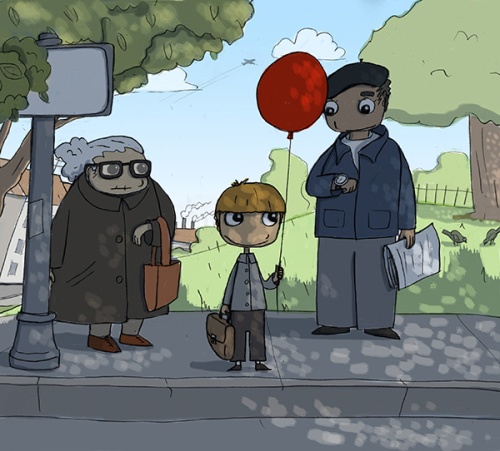
Now the characters are colored in on another layer.
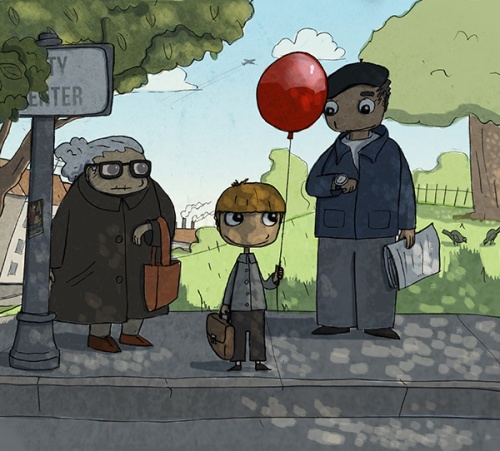
One of the biggest challenges of working in Photoshop is to make the images not look so “Photoshoppy”. So I have added a yellow layer (6%) and a water color image to add “texture”. I have also added several details, such as the balloon reflection, text on the bus sign and the little sticker on the sign post. As the image comes to life, I have fun adding in little details – this also helps with the “believability” factor.
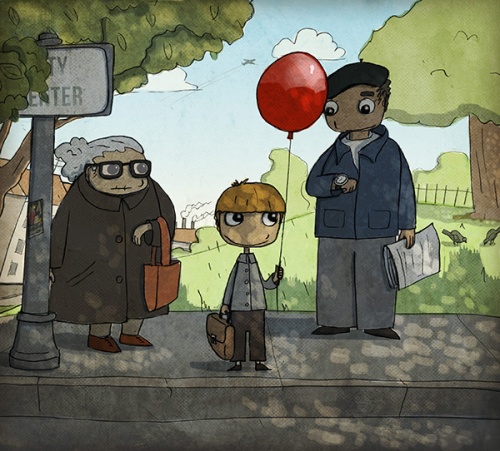
Additionally, I have added another “texture” layer (image of paint strokes on canvas) and a faint shadow around the edge of the image to give a more old-photo look.

How long have you been illustrating?
I started focusing on illustrating in 2010, but I have been painting for over 20 years. My paintings were very illustrative and often people would ask me “Why don’t you go into children’s book illustration?”
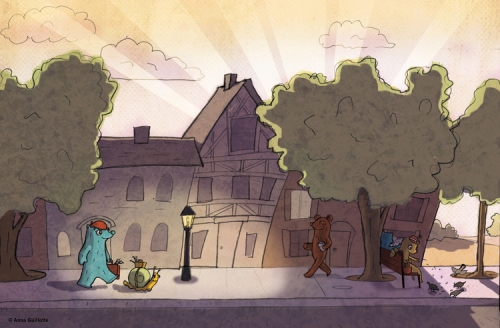
Where did you study graphic design?
I first started my studies at the University of Hartford/Hartford Art School and took every type of art class imaginable except glass blowing and jewelry. Then I studied film for a year, then moved on to multimedia (animation and video) and that’s when I finally decided to major in graphic design. I studied and majored in graphic design at Eastern Connecticut State University – my home state.
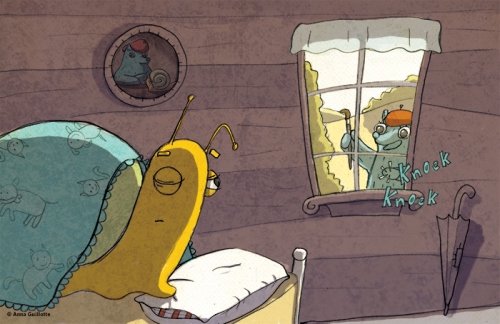
Have you attended other art related courses since studying Graphic Design?
I took a picture book illustration class and also a children’s book writing course at University of California San Diego.
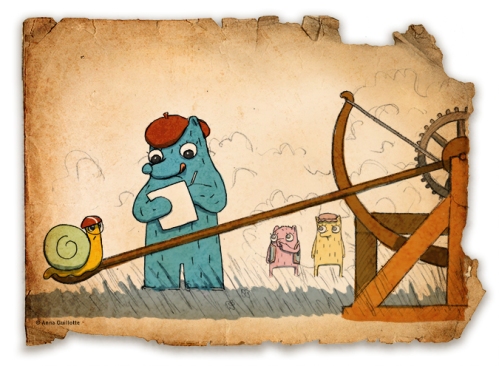
What was the first painting or illustration that you did where someone paid you for your artwork?
I painted an outdoor mural at an Elementary school in Boston.
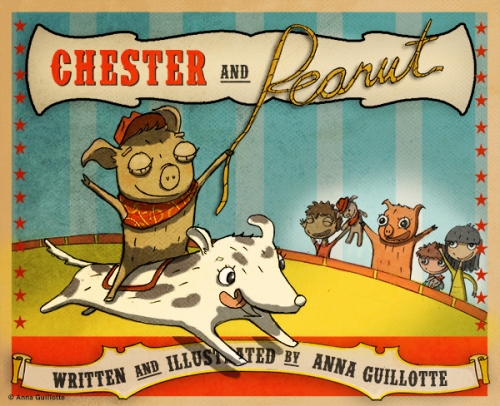
What type of job did you do right after you graduated?
I was hired as a graphic artist at Sonalyst, Inc. in Connecticut. While there, I mostly created graphics and multimedia for US Navy computer-based training, but also did graphics and web design for private companies.
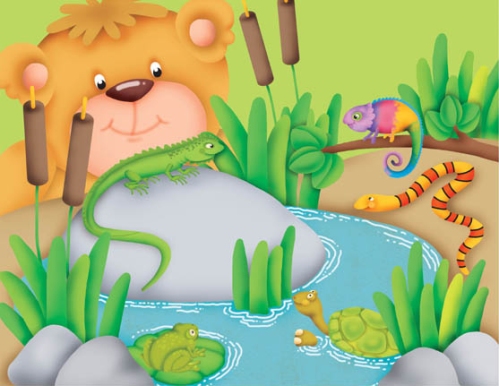
What do you think most influenced your style?
I think a lot of the shows and movies I watched as a kid influenced me. I loved the old cartoons like Tom and Jerry or Looney tunes. I’ve always been a big movie buff – not just the storytelling but also the cinematic style and I think that has carried over to my work.
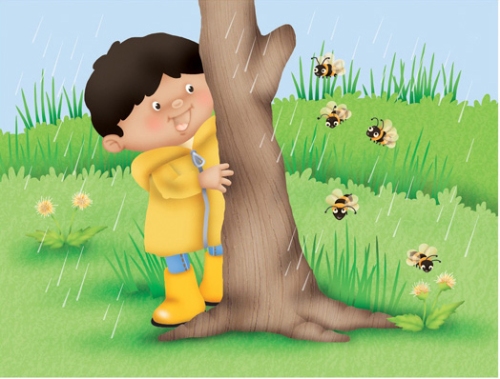
When did you decide you wanted to illustrate for children?
I signed up for an artist mentor program in San Diego in 2010. It was a program designed to help professional artists get unstuck. I was painting and doing murals but I felt my art career lacked a bit of focus. My mentor took one look at my work and suggested children’s book illustration. Her coworker knew Dan Santat from a previous job so we arranged a studio visit at Dan’s home (which Dan so graciously provided). Its funny, because at the time I didn’t know anything about children’s books and had no idea who Dan Santat was. He took the time to show me his work, how he got started, and what its like to work in the industry. After a few hours of the visit, I was sold!
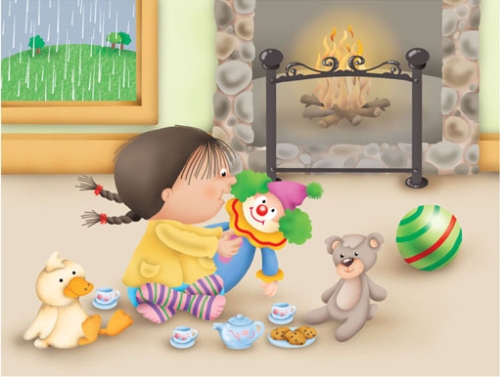
What type of art jobs have you landed?
I have worked as a graphic and multimedia artist, have done many children’s murals, and focusing on illustration work for the children’s book market and editorials.
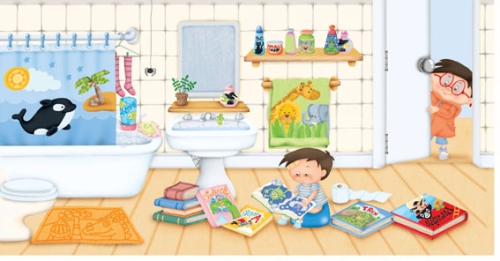
What are you doing to help connect with art directors and editors?
I have gone to many SCBWI conferences and heard art directors, agents and editors speak. It’s really helped me put a face to a name, so it doesn’t feel so abstract when sending my work to them. As far as how I connect – mostly I have sent postcards or emailed my website. I have also sent out a book dummy to several editors. I’ve also just created an email newsletter too for my contact list.
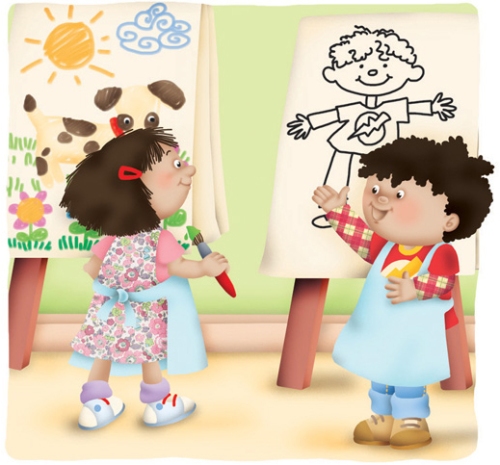
Have you put together a portfolio and or a book dummy?
I found that I have only used the physical portfolio when displaying at a SCBWI conference, otherwise I almost exclusively use my online portfolio. I have several book dummies as well, but they are mostly in digital format (PDF) as opposed to the physical book dummy format.
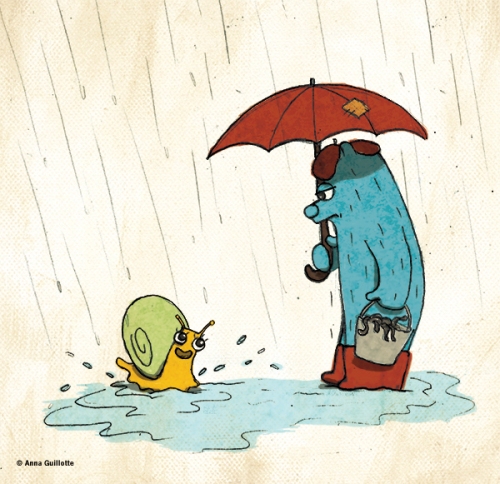
What made you decide to move to Germany?
I had no previous plans to move to Europe, but my partner got a job offer in Germany last year so I moved as well. I wrote about the decision in more detail on my blog: http://annaguillotte.com/blog/2013/11/13/why-i-am-moving-to-germany
It’s been an interesting experience to say the least and has definitely tested my limits at times. But having lived in the US my whole life, now I have the opportunity to live on the other side of the fence. Now I am the immigrant dealing with visa, work, driving, language, and cultural barriers. But since moving, I’ve had the unique opportunity to explore Europe and a experience a different lifestyle, which I think has given me an inspirational spark and influenced my work.
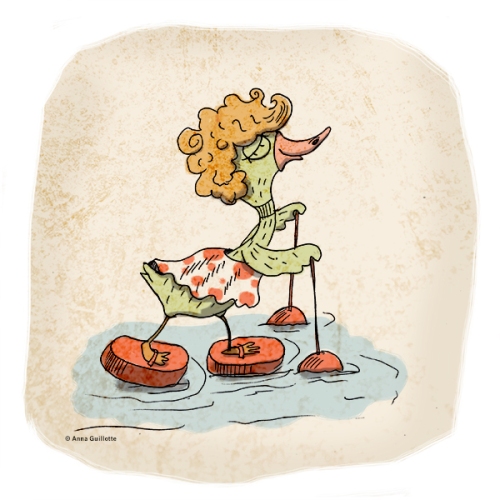
How would you compare the US market to the market for art in Germany?
For one, the German market is much, much smaller and for that reason has more international artists participating. My impression is the US market is so big and has so many talented artists that you don’t see as much artwork from outside the country.
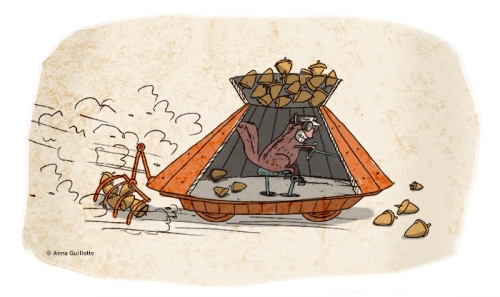
Have you exhibited your illustrations in Germany?
Not yet : )
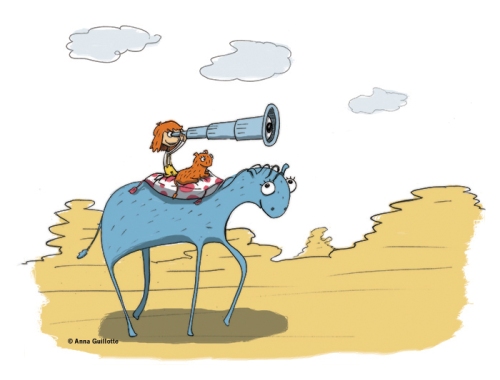
Have you done any illustrating for children’s magazines?
I have done some children’s illustrations for magazines but they were not specifically children’s magazines.
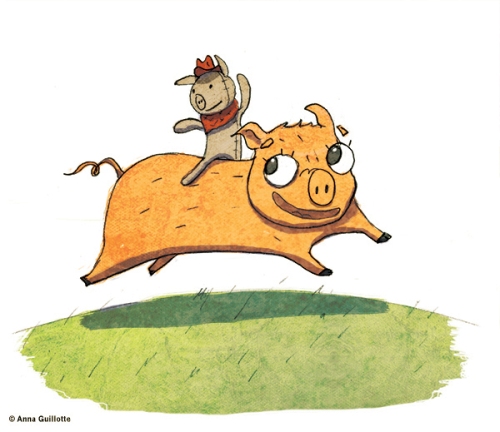
Do you have an Artist Rep. to represent you? If not, would you like to find representation?
I don’t have an artist rep now, but I would like a rep for two reasons: 1. Help with finding illustration projects and marketing so I can spend more time focusing on the creative part 2. To have a sounding board – a mutual, creative and professional relationship with someone where we can share creative ideas on how to make a project even better and enjoy the process. Though I am coming from a visual artist background, I would like to write and illustrate my own stories as well and would ideally like a representative that would work with both my art and writing or allow me to have both an art and literary agent.
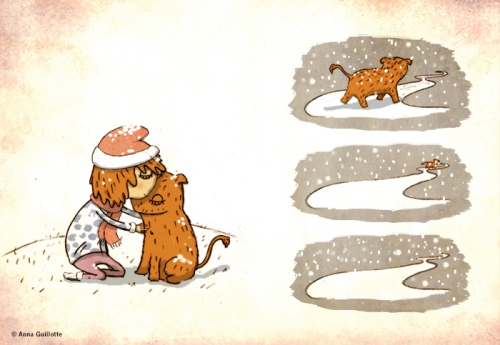
What types of things do you do to find illustration work?
I keep my website updated and have several online portfolios (Behance, LinkedIn, Devianart) so people can find me. I submit my art to magazines and illustration competitions. I also send postcards to art directors and I just made an email newsletter too.
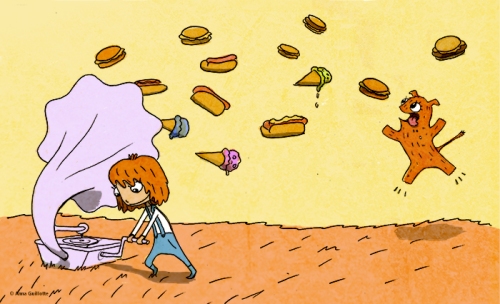
What is your favorite medium to use?
I have gravitated towards mixed media – drawing with pen, pencil, crayon, etc. scanning in and then coloring with Photoshop.
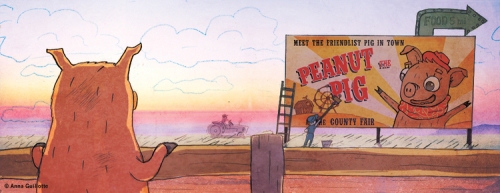
Has that changed over time?
Definitely! I used to paint using oils, then I switched to acrylic paints, then I began to import my paintings into Photoshop to edit them. About two years ago I began using Photoshop exclusively to color and have experimented using different textures to create a more natural look.
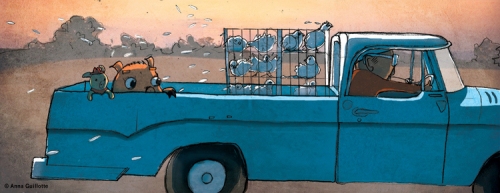
Do you take pictures or do any types of research before you start a project?
If I have a specific pose or lighting that I want to accurately capture, I will either take a photo of myself or search pictures on google images. I like to search google images also for ideas and inspiration.
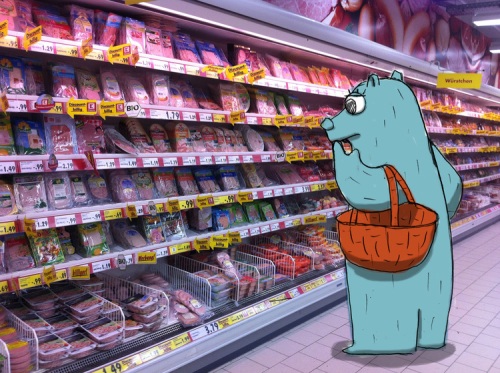
What are you working on now?
This past summer I was working on developing a story idea for one of my characters, Bearonardo. Now, I’m in a marketing mode and fine-tuning the business side of my illustrations. For example, being more consistent with contacting and updating art directors. It’s not the glamorous part, but just as important!
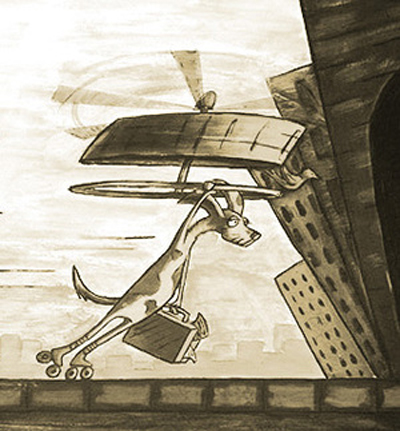
Do you want to write and illustrate a picture book?
I sure do! I have a bunch of stories I’ve written and made book dummies for. I’m definitely open to illustrating stories written by others too if they’re a good fit with me.
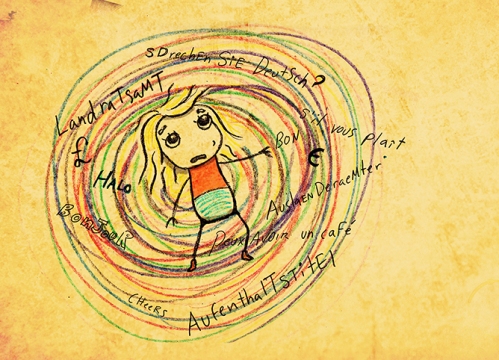 Do you have any material type tips you can share with us? Example: Paint or paper that you love – the best place to buy – a new product that you’ve tried – A how to tip, etc.
Do you have any material type tips you can share with us? Example: Paint or paper that you love – the best place to buy – a new product that you’ve tried – A how to tip, etc.
If you use Photoshop a lot in your illustrations, I would highly suggest experimenting with using different textures and patterns (whether you scan them in or find texture images online) and using the blending mode.

Thank you Anna for sharing you journey and process with us. Please let us know when your new picture books come out. We’d love to see them and cheer you on. You can visit Anna at: http://annaguillotte.com/
If you have a moment I am sure Anna would like to read your comments. I enjoy reading them, too, even if sometimes I don’t have time to reply to all of them. Thanks!
Talk tomorrow,
Kathy
Filed under:
Advice,
bio,
demystify,
How to,
illustrating,
Illustrator's Saturday,
inspiration,
Interview,
Process Tagged:
Anna Guillotte 


By: Shelf-employed,
on 9/8/2014
Blog:
Shelf-employed
(
Login to Add to MyJacketFlap)
JacketFlap tags:
disabilities,
athletes,
Non-Fiction Monday,
picture books for older readers,
bio,
painters,
Hispanic/Latino,
Advance Reader Copy,
nonfiction,
blindness,
Add a tag

Powers, J.L. 2014.
Colors of the Wind: The Story of Blind Artist and Champion Runner George Mendoza. Cynthiana, KY:
Purple House Press.
As a child, George Mendoza began seeing brilliantly-colored lights, shapes and squiggles, eventually losing most of his sight except his peripheral vision and the ever-present colors. Unable to play basketball or other do other things he wanted, George took up running. He excelled in the sport and competed twice in the Olympics for the Disabled. In the back of his mind, however, he'd kept a long-ago word advice from his youth.
One day, a flyer arrived in the mail,
advertising a contest for blind artists.
George remembered the priest, who told him,
"You should paint what you see."
George started to paint,
just like the priest told him to do.
And so began the painting career of George Mendoza.
The text appears in a plain, small font on white pages, accompanied by simple blank ink drawings, often highlighted with colors from Mendoza's paintings. Each facing page contains a full-bleed image of one of Mendoza's paintings.
Biographical information, photos of Mr. Mendoza, and painting titles are included in the book's back matter.
The joyful, riotous colors of Mendoza's paintings will certainly appeal to children, as will his story of perseverance and purpose. Enjoy!
You can see photos from Mendoza's "Colors of the Wind" exhibit at the Ellen Noel Art Museum here. The exhibit is listed with the
Smithsonian Affiliate Exhibition Exchange.
My copy of the book was provided by the author.

By: Kathy Temean,
on 7/11/2014
Blog:
Writing and Illustrating
(
Login to Add to MyJacketFlap)
JacketFlap tags:
authors and illustrators,
bio,
Illustrator's Saturday,
Andreja Peklar,
Academy of Fine Arts in Ljubljana.,
Ljubljana,
Slovenija,
awards,
Interview,
picture books,
inspiration,
Add a tag
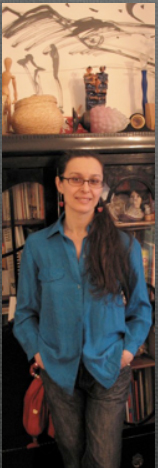 Andreja Peklar was born in Ljubljana, Slovenija.
Andreja Peklar was born in Ljubljana, Slovenija.
After studying Art history and philosophy she graduated in painting at the Academy of Fine Arts in Ljubljana.
She devoted herself to illustrating for children and her work can be seen in several picture books, text books, popular science books and magazines.
She also designed and illustrated educational material for children for several museums in Slovenija.
Her work was exhibited at various exhibitions in Slovenija and abroad (Biennial of illustration Bratislava, Golden pen Belgrade, Bibliotheque nationale de France, Paris, Museum of American Illustration at the Society of Illustrators, New York).
Andreja Peklar has also received several Slovenian and foreign awards. Some of her books have been included in The White Ravens selection.
Recently she has been focusing on writing and illustrating her own books for children. She lives and works as freelance illustrator in Ljubljana.
Here is Andreja explaining her working process:
The theme of this illustration was POTTER – it was made for partly fiction partly educational book about ancient crafts.
I start with the research. I browse a lot on internet and in different books. In this case I have searched in some historic and archeological books.
 Then I put some different ideas on a paper. I draw rough sketches with the chalk or very soft pencil.
Then I put some different ideas on a paper. I draw rough sketches with the chalk or very soft pencil.

From one idea to another …

… and finally there is a sketch I will use for the illustration. If the sketch is too small I photocopy it to the final size. I always draw illustration a little larger than it will be printed in a book.
Then I place a scetch (or a photocopy) on a light box and copy it to paper – usually Canson Montval 300gr aquarel paper. If I work out of studio I use “natural” light box – I tape a scetch on a window glass (this “tehnique” works only from dawn to dusk!)

I tape the final drawing on a plexiglass board and begin with colouring. I usually work with Ferrario’s Tiepolo tempera. First I put very bright colours using quite wide brushes.

Then I add some structures with painting knives searching for the right atmosphere…

… finishing some details …

… to the final illustration.
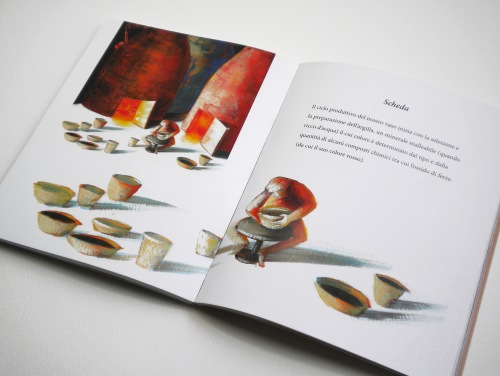
And this is how the illustration has been placed in a book.

How long have you been illustrating?
I have been illustrating for about 20 years now.

How did you decide to attend the Academy of Fine Arts in Ljubljana?
I studied philosophy and art history at first. But I have always wanted to draw. And way back in the primary school a few of us, teenagers have founded an “art group”. We were so keen that the municipality of our town has given us a nice studio in the attic of the town’s gallery (I am exhibiting my illustrations in that same gallery right now – how nostalgic!). I have spent so much of my teenage and student time there – painting, drawing, chatting about art … beautiful time … so switching to Academy of Fine Arts was somehow a logical continuation.

What were you favorite classes in college?
I have studied painting, not illustration and my favourite technique was graphics – engraving, lithography. I intend to incorporate more graphics into my illustration work right now – doing some monotypes already.

Did the School help you get work?
No, not really. We have not received “education” for living in real world. I had to learn it by myself. But on the other hand at the Academy we were taught a lot of different skills and techniques and given a lot of time to experiment. And this was a kind of help to begin living as an artist.

What was the first painting or illustration that you did where someone paid you for your artwork?
My first illustrations were black and white drawings for my friend’s book of poems when I was in high school. They were done in the name of a friendship, of course. But the first artwork I was paid for was the illustration for an old Chinese board game called Jungle.

What type of job did you do right after you graduated?
Right after I graduated I did quite a lot of drawings for stained glass, I also painted glass, taught drawing classes for a while, designed, but quickly I began illustrating.

Do you think the classes you took in college influenced your style?
No, not directly. In my opinion you hold your expression within and the style emerges later while working.

When did you do your first illustration for children?
Very soon after having graduated. It was an illustration for a series “Adventures of Goga The Millipede” for the children’s magazine Ciciban.

How did that come about?
Well, it was quite funny. My husband’s daughter (she was 7 years at the time) came to me one evening and asked me to draw 6 elephants, 6 giraffes, 6 badgers, 6… and I drew and drew… Next morning she took these drawings to school and showed them to her teacher Majda Koren, who by chance was also the editor at our main children’s magazine (and a very good author too!). And I got the job!

When did you decide you wanted to illustrate a children’s book?
The very first time I thought to be an illustrator was when I was about 10 years old. I admired the Slovenian illustrator Marija Lucija Stupica very much and therefore decided to become one myself. Then I forgot this for a while and wanted to be an archeologist, a psychologist, a chemist … gradually I came back to illustrating. Sometimes things just come to you, you don’t have to interfere much …

How long did it take you to get your first picture book contract?
A few years after I started to illustrate, I suppose.

What was your first book that you illustrated?
It was a book about old Romans.

How did you get the opportunity to exhibit at the Museum of American Illustration at the Society of Illustrators, New York?
I saw a call for entry to the 50th Annual Exhibition on internet and sent my illustration. I was very happy that it had been chosen for the Annual!

Have you illustrated any books for the American Market?
No, I have not.

Have you worked with educational publishers?
Yes, quite a lot. I’ve illustrated a lot of educational books about history for schools and museums.

How many children’s books have you illustrated?
All together about 50.

Your bio says you are writing and illustrating your own books. Are any of them finished?
Yes, two of them have already been published. I have some new projects in my mind, they are actually in different stages.

Have you done any illustrating for children’s magazines?
Yes, from the very beginning I have been illustrating for different children’s and teenage magazines.

Do you have an Artist Rep. to represent you? If so, who? If not, would you like to find one?
No, I don’t have an Artist Rep. I have been trying to find one from time to time but there are so many! And somehow I never have enough time to search among them to find one who will be just the right one!

What types of things do you do to find illustration work?
At the very beginning of my career I visited some publishing houses to show them my portfolio. After a time they usually searched me when they wanted to engage me. I also sent some submissions and query letters from time to time. And I go to Bologna Book Fair every year. I have to admit – it is more for a pleasure of seeing all these beautiful books than for business.

Do you think living in Slovenia causes you to work harder to find work?
Slovenia has a long tradition of printing way back to the 16th century albeit is a small country, which has a bright side as well as a darker one. Practically everything I do publishers can see and if they are interested they contact me. But on the other hand our market is small so there are not many publishing houses, less editions, less numbers of print runs etc. You have to work on a lot of different projects to survive. Still, I would like to be focused more on a specific kind of illustration work that I prefer.

What is your favorite medium to use?
I love tempera, it is soft and not glossy. I also like black ink for drawing expressive wide strokes with brushes or delicate drawings with fine pen.

Has that changed over time?
Yes, I like to experiment with different mediums to find a technique to go along with a particular atmosphere or feeling of a text I am illustrating.

Do you have a studio in your house?
I have a “room of my own” in our apartment, yes. But I am still dreaming of a laaaaarge studio with a very high ceiling…

What is the one thing in your studio that you could not live without?
Some brushes with specific sizes and shapes and a music background.

Do you try to spend a specific amount of time working on your craft?
Yes I do, but when it comes to deadlines – it is day and night.

Do you take pictures or do any types of research before you start a project?
I do research, for non-fiction or educational books a lot of research: from internet, books, magazines. I also have my “treasure box” in which I keep photographs, cuttings from papers, magazines, ideas, inspirations …
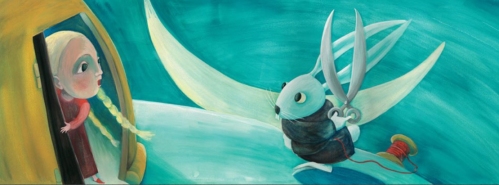
Which illustrated book is your favorite?
If I think about my books it is “The boy with a little red hood”, which I have written and illustrated. If I talk about others there are so many, so different: “Die Nacht” by Wolf Erlbruch, “Stuck” by Oliver Jeffers, “This is not my hat” by Jon Klassen, “If I were a book” by Andre Letria, “I am not a little red riding hood” by Linda Wolfsgruber, “The three golden keys” by Peter Sis and many many more.

Do you think the Internet has opened doors for you?
Yes, definitely. Sometimes I actually don’t understand how we have been working and communicating in those days before!

Do you use Photoshop with your illustrations?
I use Photoshop for my work as well.
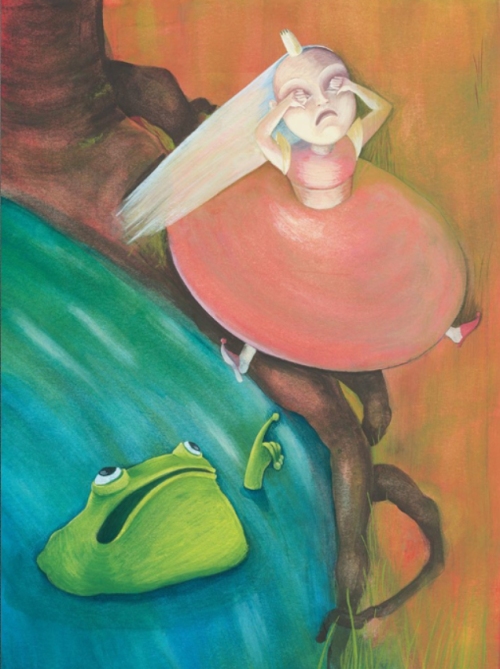
Do you own or have you used a Graphic Drawing Tablet in your illustrating?
Yes, I have Intuos 5, love it!

Do you have any career dreams that you want to fulfill?
To make more of my own books (good ones, of course!)!

What are you working on now?
I am illustrating for a children’s magazine and preparing to continue working on my own book.

Do you have any material type tips you can share with us? Example: Paint or paper that you love – the best place to buy – a new product that you’ve tried – A how to tip, etc.
Usually I am working with Canson Montval paper and Ferrario Tiepolo tempera. My favourite place to buy materials is Boesner in Austria. But you have to experiment and search for some new materials all the time!

Any words of wisdom on how to become a successful writer or illustrator?
Work hard, be honest with your work and believe in it! And if you think you can’t find an inspiration, just sit at your working table and begin drawing … the inspiration will soon come …

AWARDS
• The International Golden pen of Belgrade Award, 2007 (for the book Varuh)
• The most original Slovene picture book Award 2006 (for the book Fant z rdečo kapico)
• The most original Slovene picture book nomination 2006 (for the book Mojca Pokrajculja)


Thank you Andreja for taking the time to share your process and journey with us. We look forward to hearing about your future successes.
To see more of Andreja’s illustrations you can visit her at: http://www.andrejapeklar.si/home.html
Please take a minute to leave a comment for Andreja, I know she would love to heard from you and I always appreciate it. Thanks!
Talk tomorrow,
Kathy
Filed under:
authors and illustrators,
awards,
bio,
Illustrator's Saturday,
inspiration,
Interview,
picture books Tagged:
Academy of Fine Arts in Ljubljana.,
Andreja Peklar,
Ljubljana,
Slovenija 


Rosenstock, Barb. 2014. The Streak: How Joe DiMaggio became America's Hero. Honesdale, PA: Calkins Creek. Ill. by Terry Widener
(Advance Reader Copy)
If you know only one baseball statistic, you likely know its one "unbreakable" record - Joe DiMaggio's 56-game hitting streak. According to the Author's Note, its probability for occurrence is once every 746 to 18,519 years. It was the most talked about news story of 1941, even edging out news of the war raging in Europe.
Oil-painted illustrations evoke the bygone era; references to new immigrants and mention of the war in Europe place the story in the context of history. However, The Streak is essentially a story of baseball, one man, and his favorite bat, Betsy Ann.
When DiMaggio was up, he strolled to home plate. He didn't pull at his cap, scuff his feet, or make Betsy Ann dance behind his head. He rubbed dirt on his hands, tapped the plate just once, and set his wide-legged stance. For a minute, Joe stood perfectly still, then he and Betsy Ann went to work.
The book includes: Author's Note, Statistics, Source Notes, Bibliography, Acknowledgments
Baseball, it's my favorite season of the year. Enjoy
The Streak: How Joe DiMaggio became America's Hero, and be sure to take in a baseball game this summer. You may witness history in the making. You never know.
Other reviews at
If you're looking for another great picture book about Joe DiMaggio, the 1941 baseball season, or "the streak," be sure to check out
The Unforgettable Season: The Story of Joe DiMaggio, Ted Williams, and the Record-Setting Summer of '41.
This YouTube link will let you see Joe DiMaggio's famous swing and hear Les Brown's popular song of the day, "Joltin' Joe DiMaggio."

" Saucy is a real character dealing with real stuff—hard stuff that doesn’t have easy answers, not in real life and not in fairy tales, either. This is a really compelling and ultimately hopeful story. Highly recommended."
– Debby Dahl Edwardson, National Book Award finalist and author of
My Name is Not Easy
Read a sample chapter.
One of the online tools I use weekly is AuthorCentral.com, which is an Amazon site with a backend for authors. It gives authors access to the listings about your book, statistics about sales, reviews of all your books on a single page and access to Amazon for correcting mistakes.
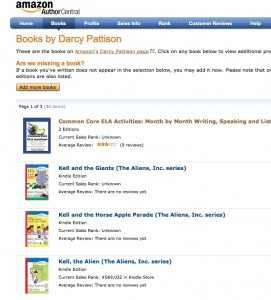
Typical page from AuthorCentral. I’ve just “claimed” by Aliens, Inc. Series which will be out in August, 2014.
When you log onto AuthorCentral, the first thing to do is claim your books. Click on the Books tab at the top, and then ADD BOOKS. Once the process is completed, you’ll have access to the book listing, book details and book extras. These shouldn’t be changed willy-nilly, as your publisher has likely spent time in honing the description. But you do have access to change anything that is wrong, to add good news about awards and such, and to tweak as needed. Indeed, there is a space for “FROM THE AUTHOR” which gives you the perfect place to add information. The Book Extras are primarily intended for Shelfari, which isn’t one of the most popular sites; often, I don’t bother to do anything here. But it’s available if you like.
Profile. The profile tab offers simple access to your Amazon Author page, something you want to update a couple times a year, or as new information is available. Included are you bio, bibliography, photos, videos, blog feeds and the ability to list events.
Sales Info. This includes sales data over time and by geographic region, as reported by BookScan. That is important: this only includes sales data from BOOKSCAN. Still, this is important and helpful. Say you visited California and wanted to know the effect of that visit on sales. You could check the sales data the next week. The information is also broken down book by book.
Author Rank. Just like Amazon gives your books a sales rank, it also gives YOU a sales rank. For a certain time period, how did your sales stack up against other authors in your category? I tend to ignore this one.
Customer Reviews. On the other hand, I check my customer reviews about once a week. It’s convenient to have all reviews from all your books in one central location. Otherwise, I’d have to visit each book listing on Amazon to see new reviews. It’s a bit slow (24-48 hours) pulling in a review. When a friend emails to say s/he has posted a review, I can check the book page and see it immediately; however, it doesn’t show up on AuthorCentral for a day or two.
Overall, these tools allow writers to keep a pulse on their book sales. It’s been a valuable addition to my set of online marketing and promotional tools. Thanks, AuthorCentral.


By: Shelf-employed,
on 5/19/2014
Blog:
Shelf-employed
(
Login to Add to MyJacketFlap)
JacketFlap tags:
YA,
history,
book review,
adult,
science,
J,
scientists,
medicine,
bio,
digital audiobook,
Add a tag
Angus, David. 2013.
Great Men and Women in the History of Medicine. Read by Benjamin Soames. Naxos Audiobooks.
It is a shame that this compendium of influential people in the history of medicine is not available in print or e-book format. It would be a great reference for students doing research or biography reports. Don't let the audio book format deter you, however. As I wrote in my review for
AudioFile Magazine (linked below), Benjamin Soames conveys a fascination for his topic that is infectious! (pun intended)
Some of the people featured in
Great Men and Women in the History of Medicine include:
Hippocrates, Galen, Hildegard of Bingen, Ibn Sina, Al-Razi, Andreas Vesalius, William Harvey, Edward Jenner, Crick and Watson. You may not know their names, but their discoveries have benefitted you. I'm not sure of the best audience for this book, but I can tell you that I thoroughly enjoyed it.
Read my review of Great Men and Women in the History of Medicine for AudioFile Magazine here.Listen to an audio sample of Great Men and Women in the History of Medicine here.

By: Shelf-employed,
on 3/31/2014
Blog:
Shelf-employed
(
Login to Add to MyJacketFlap)
JacketFlap tags:
YA,
book review,
nonfiction,
artists,
Mississippi,
J,
pottery,
picture books for older readers,
39 Clues,
bio,
Add a tag
 Greenberg, Jan and Sandra Jordan. 2013. The Mad Potter: George E. Ohr, Eccentric Genius. New York: Roaring Brook.
Greenberg, Jan and Sandra Jordan. 2013. The Mad Potter: George E. Ohr, Eccentric Genius. New York: Roaring Brook.
This book, recognized as a Robert F. Sibert Honor Book, one of 2013's most distinguished informational books, is a photo-filled biography of George E. Ohr, a master of art pottery. A colorful character and far cry from the reticent or taciturn artist stereotype, Ohr was a self-proclaimed,
"rankey krankey solid individualist," the "Greatest Art Potter on Earth," and "born free and patriotic, blowing my own bugle."
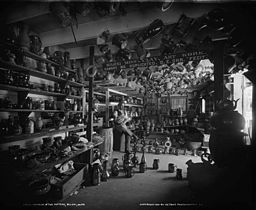 Sadly, his bravado did not serve him well in his lifetime, as one fan wrote,
Sadly, his bravado did not serve him well in his lifetime, as one fan wrote,
"Mr. Ohr is by no means a crank, but is a naturally bright, even brilliant man, who has been led into the belief that the way for him to attain publicity is through the channel of preposterous advertising, and the signs which he placed round Biloxi do him more harm than good."
Still, he was confident in his own mastery of his craft, and future generations came to recognize that he was indeed brilliant. The
Ohr-O'Keefe Museum of Art was built in his honor, and houses a permanent exhibition of his work.
The Mad Potter is a narrative chronology and includes a history of the museum, instructions on how to create a clay pot, extensive Notes, Bibliography and Picture Credits, and my favorite - "How to Look at a Pot," a useful interpretation of the language and method used in describing and evaluating pottery.
A fascinating glimpse into an artist's life, the art of pottery, and the nature and mindset of the art-collecting world.
Note:Want to see the works of George Ohr? There is a Pinterest board titled, "George Ohr & His Biloxi Pottery," dedicated to displaying photos of George Ohr and his creations. Be sure to take a gander.
Today is
Nonfiction Monday, and also the final day of our
KidLit Celebrates Women's History Month celebration. Please be sure to catch up on all of the wonderful posts!


By: Kathy Temean,
on 9/24/2013
Blog:
Writing and Illustrating
(
Login to Add to MyJacketFlap)
JacketFlap tags:
authors and illustrators,
bio,
Children's Book Author,
dianne Ochiltree,
book give-a-way,
It's a Firefly Night,
Author,
Interview,
Picture Book,
Book,
Add a tag
 Dianne Ochiltree has been writing stories and poems since she was a child growing up in a small Midwestern town. Today, she is a nationally recognized author of books for the very young. Her picture book, LULL-A-BYE, LITTLE ONE has been a selection for the Dollywood Fourndation’s national literacy program, and her picture book, MOLLY BY GOLLY! The Legend of Molly Williams, America’s First Female Firefighter received the Florida Book Awards Bronze Medal in the Children’s Literature category in 2012. Her earlier books have been translated into foreign language and Braille editions as well as audio versions. For more information about Dianne and her books, go to http://www.ochiltreebooks.com. Dianne lives in sunny Sarasota, Florida with her husband, Jim, and the family pets.
Dianne Ochiltree has been writing stories and poems since she was a child growing up in a small Midwestern town. Today, she is a nationally recognized author of books for the very young. Her picture book, LULL-A-BYE, LITTLE ONE has been a selection for the Dollywood Fourndation’s national literacy program, and her picture book, MOLLY BY GOLLY! The Legend of Molly Williams, America’s First Female Firefighter received the Florida Book Awards Bronze Medal in the Children’s Literature category in 2012. Her earlier books have been translated into foreign language and Braille editions as well as audio versions. For more information about Dianne and her books, go to http://www.ochiltreebooks.com. Dianne lives in sunny Sarasota, Florida with her husband, Jim, and the family pets.
 Her books have appeared on several recommended reading lists nationwide, including the Bank Street College Children’s Book Committee ‘year’s best’, and the Dollywood Foundation’s national childhood literacy program, ‘imagination library’.
Her books have appeared on several recommended reading lists nationwide, including the Bank Street College Children’s Book Committee ‘year’s best’, and the Dollywood Foundation’s national childhood literacy program, ‘imagination library’.
IT’S A FIREFLY NIGHT is illustrated by Betsy Snyder who was featured last December on Illustrator Saturday. If you would like to see that post, here is the link: http://kathytemean.wordpress.com/2012/12/01/illustrator-saturday-betsy-snyder/
Dianne has agreed to give everyone a chance to win one of three signed copies of IT’S A FIREFLY NIGHT. All you have to do is leaves a comment to get their name in the hat one time. If you would like to collect more entries in the hat, you can increase your chances by do the following:
1 entry everything you tweet this link (One a day).
1 entry for putting this link on facebook
1 entry for putting up this post on your blog.
2 entries if you reblog this post.
5 entries if you talk about the book on your facebook page or blog.
Please come back and leave an update on what you did by Friday October 5th in the comment section, so I know how many times to put your name in the hat for the drawing. I will announce the winner on Sunday October 7th.
Here is the interview I had with Dianne.
I know you have been writing since you were a little kid, but how did you hone your writing skills as a serious writer?
Great question! First, I made the commitment to write something very day. Depending on the particular day, some days it was 20 pages and other days it was only notes on a future project. The important thing was to make the writing a daily priority. Second, I made a list of what I didn’t know about writing for young readers and the children’s publishing industry. (Initially, a very long list!) Then I set off on a crash course to gain the knowledge I needed to write effectively for this market. I read books, magazine articles, and blogs on the topics. I took a couple of in-person and online classes. Most important, I joined SCBWI. The first year in the business, I attended eight regional and national conferences, where the workshops and presenters shared valuable tips on the craft and business of writing for children. I networked with fellow beginning writers. I found experienced writers who generously offered me guidance from time to time. I joined two critique groups where I could not only bring my own writing skills up to speed, but also learn from evaluating other writers’ work. Oh yes, it ‘takes a village’ to raise a children’s writer!
Were the first things you wrote, poems?
Yes, little poems about pets and flowers and that sort of thing. Also scripts for puppet shows. I made hand puppets from paper lunch bags and construction paper. My third grade teacher let me do puppet shows for my book reports because I was so shy! Before learning to actually read or write, I drew little ‘picture books’ using recycled paper sheets , bound with punch holes and yarn.
Did you start out knowing that you wanted to writer for children?
Not at all. I just wrote things without thought about intended readership or publication at first. It was just for fun.
Have you done any other type of writing?
My first job was as an advertising copywriter. My first writing career, as staff writer and freelancer, was in marketing/advertising/public relations. I have written poems and personal essays for adult readers, too.
When did you get your first picture book published?
My first book for children, CATS ADD UP!, was published in 1998 as a title in the ‘Hello, Reader!’ series from Scholastic. This was especially exciting to be published by Scholastic, because when I was a kid, most of my reading material came from those monthly book club offerings.
How did that happen?
I’d applied for the Rutgers One-on-One Plus Conference with a writing sample, an early draft of that first published book, and was accepted. My mentor that day was Paula Danziger. Not only did she give me priceless writing advice…she introduced me to an editor at Scholastic who agreed to look at my manuscript once I’d made revisions based on her input.
Are all your picture books in rhyme?
No. All three of my ‘Hello Reader!” series titles are in prose, as is my 2012 Calkins Creek/Boyds Mills Press book, MOLLY BY GOLLY! The Legend of Molly Williams, America’s First Female Firefighter.
Do you have an agent? If not, would like to find one?
No, I do not currently have an agent. And YES, of course, I’d love to have representation. It’s not just the negotiation for the initial contract in which a literary agent makes a key difference—it’s the on-going interface with the publisher on issues such as subsidiary rights in which having an agent on your side can make a big impact.
Not counting your latest book, which book are you most proud of?
Now you’re asking me to name the equivalent of my favorite child—tough question! So, while I love all my books, I am proud of LULL-A-BYE, LITTLE ONE (G.P. Putnam’s Sons, 2006) for being on the Dollywood Foundation’s ‘Imagination Library’ list for many years running. Because of this, thousands of families with infants have received a free copy of the book in the mail for their own little ones. These are parents who could not otherwise afford books for their kids. Also proud that the ‘Molly’ book won the 2012 Florida Book Awards bronze medal in the children’s literature category.
Do you have a regular writing schedule?
The only regular thing about my writing schedule is that I write something each day: a journal entry, a blog post, or chunks of a manuscript. It’s all good.
I see you do yoga. Do you feel that helps you write better?
Yes, I’m a Yoga Alliance 200-hour RYT instructor and devoted lifelong learner. And yes, it helps tremendously. As an instructor or student, my observational skills need to be engaged at a high level. This also helps make writing shine, taking notice of all the details. There is a meditative state that practicing yoga and writing share. By connecting with your true self, or your creative self, your work on the mat and at the keyboard will exceed your expectations. There is also an element of non-judgment of effort and non-attachment to results that frees up a yoga practice and writing efforts alike. I believe so strongly in the corollary processes that I teach a ‘zen and the pen’ workshop from time to time.
Can you tell us the story and journey behind your new book, It’s a Firefly Night?
It’s been a long and happy journey with that manuscript. I think my first draft of the story dates to 2003. It was prompted by my memory of sharing ‘firefly nights’ with my own father. From him, I learned an appreciation of—and a respect for—the natural world. That’s a lesson as valuable today as it was in the 60’s. Catching fireflies on a summer night was one of the rare times I had one-on-one time with my father. My father passed away when I was 18 years old, so of course working creatively with any ‘daddy memory’ is a special pleasure for me. It has also been a joy to connect with that childlike sense of wonder while crafting this manuscript. My goal was to share the feeling of magical, barefoot, starry summer nights of long-ago with today’s kids. I also hope that the book inspires today’s parents to get out there and share some nature outings with their children.
What number of books does this book bring you up to now?
I think it’s 11.
Have any of your books been put out as an e-book?
Yes, some of my Scholastic books are now offered as an e-book. Both original Scholastic publications and picture books that were subsequently sold to Scholastic for paperback and other rights.
Do you have any thoughts on why some writer’s get published and others do not?
Some writers do the homework and some do not. Some writers can receive editorial input and utilize it effectively, some cannot. Some writers can handle rejection, others cannot. Some writers give up, others do not. The biggest difference? Published writers are not quitters.
Do you have any suggestions on how to market yourself to editors and publishers?
Simply, be professional. Know what they do or do not publish. Ask informed questions. Use appropriate communication channels for your queries and pitches. Only present your most polished work.
What are you working on now?
A book proposal for a juvenile biography, plus a narrative nonfiction picture book manuscript.
Do you have any words of wisdom for unpublished writers?
I’m not really qualified to give anything as profound as words of wisdom…but I will mention that it’s important to find out what makes your writing stand out from other authors, which is another way of saying what makes you unique, then go for it! Let your writing express your viewpoint on life, as well as your personality. You were called to be a writer because there is something you really need to say to young readers. Make that connection with every word on the page.
Thank you Dianne for sharing your time to answer todays, interview questions. I have your book and it is a great addition to my picture book collection and thank you for your generous offer to let three people win signed copies of your book.
Talk tomorrow,
Kathy
Filed under:
Author,
authors and illustrators,
bio,
Book,
Interview,
Picture Book Tagged:
book give-a-way,
Children's Book Author,
dianne Ochiltree,
It's a Firefly Night 

Many months ago, I requested a copy of Hit By Pitch from LibraryThing's Early Reviewers program. I was thrilled that I was chosen to receive a copy, but it never showed up -- until last week, when I eagerly devoured it, and was not disappointed. This one's not for *kids, but certainly suitable for young adults.
Lawless, Molly. 2013. Hit By Pitch: Ray Chapman, Carl Mays and the Fatal Fastball. Jefferson, NC: McFarland.
If you've ever watched a player get beaned by a baseball, you've experienced the sickening feeling that occurs merely from watching. In 1920, fifty years before the mandated use of batting helmets, Cleveland Indian shortstop, Ray "Chappie" Chapman, became the first and only major league baseball player to be killed by a pitched ball. This is his story
and the story of pitcher, Carl Mays of the New York Yankees.
In some ways, it is easy to write about sports as the statisticians make the research simple - dates, times, players, locations, runs, hits, balls, strikes, averages - it's all recorded history. However, the single entry in the scorer's book for the game at the Polo Grounds between the Cleveland Indians the New York Yankees, "hit by pitch," cannot explain the tragic story of baseball's only fatal beaning on August 16, 1920. Molly Lawless uses black and white drawings, period quotes, newspaper articles, and sportswriter commentaries to animate this story for a new generation.
A more perfect tragedy could not be conceived if it were a work of fiction - the odd, sullen and nearly friendless "villain," Carl Mays, versus the cheerful, handsome and beloved athlete, businessman, husband and friend, "Chappie." One will live and one will die. Both stories end in tragedy.
Fascinating, well-researched, and told with a keen eye for the game and all its intricacies and idiosyncrasies. Ms. Lawless' respect for (and love of) baseball is apparent in every page. Her black and white illustrations evoke the time and spirit of the game in the "deadball era," and an American public, still processing the effects of the 1919 Black Sox Scandal and the relatively new phenomenon of Prohibition. Fans of baseball, graphic novels, history or tragedy will love this book.
*For younger readers interested in this topic, Dan Gutman's,
Ray & Me (Harper Collins, 2009), tells the tragic story as part of his
Baseball Card Adventures series, combining fact, fiction and a hint of fantasy as the young protagonist travels back in time to great moments in baseball history.

By: shelf-employed,
on 1/21/2013
Blog:
Shelf-employed
(
Login to Add to MyJacketFlap)
JacketFlap tags:
opinion,
bio,
Add a tag
![By In Helmolt, H.F., ed. History of the World. New York: Dodd, Mead and Company, 1902. Author unknown, but the portrait has several centuries [Public domain or Public domain], via Wikimedia Commons](https://upload.wikimedia.org/wikipedia/commons/2/2a/Hw-shakespeare.png) |
By In Helmolt, H.F., ed. History of the World.
New York: Dodd, Mead and Company, 1902.
Author unknown, [Public domain or Public domain],
via Wikimedia Commons |
Whether you're a school media specialist, a public librarian, a parent or a teacher,
if you know children over the age of 7, you're familiar with "the biography assignment." It comes around every year, and depending one's perspective, it may be a source of excitement, drudgery, irritation, disappointment, interest, or a mixture of all.
Some thoughts on "the biography assignment"
 Children need to understand the difference between an autobiography and a biography.
Children need to understand the difference between an autobiography and a biography. Many students arrive at the library insistent that their teacher has assigned an autobiography and a biography will not suffice. I always try to comply with their request, however, there are few autobiographies written for children, though if the child is slightly older, I will always recommend Jon Scieszka's,
Knucklehead (hands down, the best and funniest autobiography for children). For older kids, Walter Dean Myers and Gary Paulsen have both written excellent memoirs. In most cases, the teacher will accept either an autobiography or a biography, but children don't always realize that.
Graphic novels biographies are perfect in certain circumstances and I wish more people would give them a try. A reluctant reader might love Terry Collins',
King of Pop: The Story of Michael Jackson, or any title from the American Graphic Biography Collection, or other similar offerings. Just because they have panels, that doesn't make them less true, less valuable, less informative.
Picture book biographies are not just for very young children - in fact, seldom are. There are
so many wonderful and informative picture book biographies. I urge teachers to read a few and give them a chance. Demi's books are not only informative, but beautiful and evocative -
Marco Polo, for example is simply stunning. Or how about
Bill The Boy Wonder by Marc Tyler Nobleman? Or Michelle Markel's,
The Fantastic Jungles of Henri Rousseau? I could go on for days ...
The most important thing to look for in a biography is veracity. Are there source notes, back matter, photo credits, suggestions for additional reading - in short, all of the things that indicate the author has thoroughly researched the subject? Has the author taken "artistic license?" That's not necessarily a bad thing, however, older students should be trained to look for it.
The point is, I understand the dictates of local, state and national policies on what must be taught to children, however, within the parameters of those dictates, there is, hopefully, some room for flexibility - some leeway for children to choose different formats, different topics, different means of delivery. To this day, I don't like the poetry of Percy Bysse Shelley. Why? Because when I was in grammar school, I wanted to do my "famous poet" report on Edgar Allen Poe. I was forced to choose Percy Bysse Shelley. I've long forgotten that teacher's name, and I still don't like Shelley. In another year, a wonderful teacher allowed me to choose Edgar Allen Poe. Her name was Ms. Romano and I still read Poe from time to time. See how it works?
When the biography assignment rolls around, keep your options open!

One more thing:
I haven't had one in hand yet, but Abdo Publishing has a new series of
Children's Author biographies. Tell me what young boy given a biography assignment would not want to choose,
Dav Pilkey?
Related posts:

By: shelf-employed,
on 12/16/2012
Blog:
Shelf-employed
(
Login to Add to MyJacketFlap)
JacketFlap tags:
poetry,
nonfiction,
science,
favorites,
disabilities,
autism,
Non-Fiction Monday,
leaves,
announcement,
bio,
STEM,
Add a tag
As 2012 is quickly coming to a close, I'll use today's Nonfiction Monday event to feature my two favorite nonfiction books of the year - one for young listeners and one for older readers.
Without a doubt, my favorite nonfiction book for older readers was
Educational, inspirational, celebratory!
Though I first reviewed it in March, it has remained on the top of my list. Click the title for my review.
Rhyming, whimsical, gorgeous illustrations!
(click the title for my review)
If you haven't checked out these two nonfiction books yet, hurry to your library or bookstore!
They're not to be missed!

By: shelf-employed,
on 8/20/2012
Blog:
Shelf-employed
(
Login to Add to MyJacketFlap)
JacketFlap tags:
painters,
Henri Rousseau,
book review,
nonfiction,
artists,
J,
Non-Fiction Monday,
picture books for older readers,
bio,
Add a tag
Markel, Michelle. 2012.
The Fantastic Jungles of Henri Rousseau. Ill. by Amanda Hall. Grand Rapids, MI: Eerdmans.
Review copies provided by LibraryThing and publisher.I can't imagine many tasks more difficult than painting illustrations for a biography of a famous painter. In a book for adults, the artist's actual work speak for itself, but in a picture book for children, the art must not only speak for its creator, but it must help to tell a story. For
The Fantastic Jungles of Henri Rousseau, illustrator Amanda Hall eschewed her usual medium in favor of watercolor and acrylics, seeking to more closely mimic Rousseau's style in order to help tell his story. More than mere imitations, however, she uses Rousseau's style and perspective as the medium to illustrate the time and place in which he lived, his joyous spirit, his famous contemporaries, his wonder at the natural world, and most of all, his complete commitment to his craft - regardless of how it is received by others. Her illustrations are the perfect complement to Michelle Markel's prose, delivered in a present tense fashion that immediately engages the reader. In language that will speak clearly to children, Markel clearly conveys the transformative power of art,
By now Henri is used to the nasty critics. He knows his shapes are simpler and flatter than everyone else's, but he thinks that makes them lovely. He spends all he earns on art supplies, and pays for his bread and coal with landscapes and portraits. In the afternoon he takes off his frayed smock and gives music lessons. His home is a shabby little studio, where one pot of stew must last the whole week. But every morning he wakes up and smiles at his pictures.
Poverty and rejection have never sound so appealing. Henri Rousseau's life story is an inspiration. A toll collector who did not take up painting until his forties, Rousseau was untrained and largely unrecognized while living, but he was unfazed. He later became "the first "n
aïve" artist to be recognized as a great master," and his works now hang in museums around the world.
Author's and Illustrator's Notes complete this stunning picture book biography for older readers.
Enjoy the book's trailer and "Spring," one of Rousseau's famous jungle paintings.
Other reviews @

By: shelf-employed,
on 7/16/2012
Blog:
Shelf-employed
(
Login to Add to MyJacketFlap)
JacketFlap tags:
comic book,
book review,
comics,
nonfiction,
writers,
Batman,
Non-Fiction Monday,
picture books for older readers,
bio,
Add a tag
Nobleman, Marc Tyler. 2012.
Bill the Boy Wonder: The Secret Co-Creator of Batman. Ill. By Ty Templeton. Watertown, MA: Charlesbridge.
Batman. Who doesn’t know Batman in one format or another? The 1960s TV show, the incredibly popular
Dark Knight movie series, cartoons, and of course, the original comic books which first appeared in 1939, bearing the name of Batman creator, Bob Kane.
Every Batman story is marked with the words “Batman created by Bob Kane.”
For almost thirty years, fans did not suspect otherwise. But that is not the whole truth. Bob Kane himself said so.
A Finger had a hand in it, too.
Bill the Boy Wonder is the story of that Finger, Bill Finger, the co-creator and long-time writer of
Batman.
First forced to hide his identity as a Jew (his real name was Milton) to obtain work during the Great Depression, later writing in obscurity while Batman illustrator, Bob Kane, rose to fame, and finally working (if only half-heartedly) to gain his duly deserved recognition, Nobleman chooses to present
Bill, The Boy Wonder as a story with three parts, "Secret Identity 1 – Bill," "Secret Identity 2 – Writer of Batman," and "Secret Identity 3 – Co-creator of Batman." This well-sourced and researched biography is as fascinating as it is entertaining,
Bill liked to ride through the city to think. As the bus picked up passengers, Bill picked up plots from street scenes and daydreams.
He recorded stray facts – the boiling point of mercury, the Chinese character for virtue, what happens when a dog’s nose get scold – in what he called his “gimmick book.” He routinely skimmed it for a spark that might ignite a story. In time he had a library of gimmick books at his Fingertips. He even let other writers – his competitors – hunt for story ideas in them.
Though brimming with details and quotes, Templeton moves the story along with the talent of a comic book writer. A six-page Author’s Note adds details and period photographs.
Ty Templeton, a Batman artist himself, was the perfect choice to illustrate this fascinating look at Bob Finger’s work and the work of other talented artists, writers and fans who struggled to garner for him the credit he deserved. The end papers are dramatic and inspired, and the illustrations are done, of course, in comic book style with white text box insets.
Even if you’re not a Batmanian, you’ll love this book. It's clear that it was a labor of love for the author.
(I'll be showin

By: shelf-employed,
on 7/2/2012
Blog:
Shelf-employed
(
Login to Add to MyJacketFlap)
JacketFlap tags:
YA,
graphic novel,
book review,
nonfiction,
series,
J,
Non-Fiction Monday,
musicians,
Michael Jackson,
bio,
singers,
Add a tag

I haven't seen this entire series, but I think that the
American Graphic biographies by Capstone Press may fill two needed niches. The first, and probably the intended purpose is to fill the need for easy reading biographies that will interest older kids. A secondary benefit, however, is that these books can bring complex historical figures to a level where they can be understood by young elementary schoolers who so often express interest in people and things way "beyond their years."
First up, the King of Pop
Collins, Terry. 2012.
King of Pop: The Story of Michael Jackson. Ill. by Michael Byers. North Mankato, MN: Capstone Press.
Written largely as a first-person account, ten short chapters chronicle Michael Jackson's life, focusing both on his genius and his pecularities, though not going in to
great detail regarding the latter. A two-page illustration of tabloid headlines offers the reader a glimpse into Michael's personal life, but "Thriller" and "Billy Jean" are also illustrated expansively - including his famous moonwalk. The book concludes on a positive note with a collage of the many faces of Michael Jackson and the following summation,
And in his heart, he was still a little boy who never grew up ...
... and the world is all the richer for it.
The panels are easy to follow and have easy to read text. This graphic novel biography concludes with two pages of standard text titled, "The Legacy of Michael Jackson," followed by a Glossary (which includes
eccentric and
surrogate, as well as
innovation and
mourn), sites and books where more information can be found, and a small index.
I predict this one will be popular.
Next up,
Hip-Hop Icon: Jay-Z
This book never even made it onto the shelf! Within minutes of receiving it, a young adult male spotted it on my desk and asked to borrow it. Sometimes, a little bit of information is enough - perhaps that's a third niche for these easy-reading comic style biographies.
Other titles in the American Graphics series include:
ELVIS: A Graphic Novel, Obama: The Historic Election of America's 44th President, Sara Palin: Politcal Rebel, The Bambino: The Story of Babe Ruth's Legendary 1927 Season. A complete list of the American Graphic biography collection is available on Capstone's site.
Also on the site are complete readability statistics - ATOS, Lexile, and GR. These high-interest, low-level biographies are suggested for grad
I canceled today’s post, because even though you probably have heard of Maurice Sendak passing away yesterday, he really deserves to have it recognized.
Maurice Sendak, widely considered the most important children’s book artist of the 20th century, who wrenched the picture book out of the safe, sanitized world of the nursery and plunged it into the dark, terrifying and hauntingly beautiful recesses of the human psyche, died on Tuesday in Danbury, Conn. He was 83.
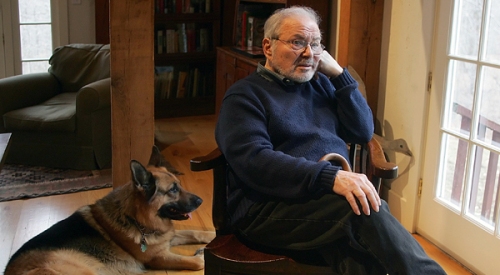
Mr. Sendak’s books were essential ingredients of childhood for the generation born after 1960 or thereabouts, and in turn for their children. He was known in particular for more than a dozen picture books he wrote and illustrated himself, most famously “Where the Wild Things Are,” which was simultaneously genre-breaking and career-making when it was published by Harper & Row in 1963.
Among the other titles he wrote and illustrated, all from Harper & Row, are “In the Night Kitchen” (1970) and “Outside Over There” (1981), which together with “Where the Wild Things Are” form a trilogy; “The Sign on Rosie’s Door” (1960); “Higglety Pigglety Pop!” (1967); and “The Nutshell Library” (1962), a boxed set of four tiny volumes comprising “Alligators All Around,” “Chicken Soup With Rice,” “One Was Johnny” and “Pierre.”
In September, a new picture book by Mr. Sendak, “Bumble-Ardy” — the first in 30 years for which he produced both text and illustrations — was issued by HarperCollins Publishers. The book, which spent five weeks on the New York Times children’s best-seller list, tells the not-altogether-lighthearted story of an orphaned pig (his parents are eaten) who gives himself a riotous birthday party.
To rest the rest of the article written by MARGALIT FOX in May 8th New York Times, click the link below:
http://www.nytimes.com/2012/05/09/books/maurice-sendak-childrens-author-dies-at-83.html
Christina Tugeau’s post: http://catugeau.wordpress.com/2012/05/08/loss/
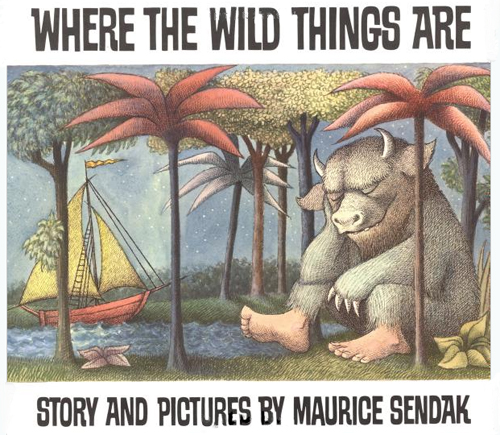
Mr. Sendak, thank you for your wonderful contribution to children’s books. You will be missed! We all are happy that we can still have a part of you and share your talent with the generations to come.
Talk tomorrow,
Kathy
Filed under:
authors and illustrators,
bio,
News,
Uncategorized Tagged:
Goodbye,
Maurice Sendak,
Where The Wild Things Are 
 9 Comments on Maurice Sendak, last added: 5/10/2012
9 Comments on Maurice Sendak, last added: 5/10/2012

By: shelf-employed,
on 4/16/2012
Blog:
Shelf-employed
(
Login to Add to MyJacketFlap)
JacketFlap tags:
explorers,
bio,
Women's history,
marine life,
book review,
nonfiction,
science,
ocean,
ecology,
Non-Fiction Monday,
picture books for older readers,
Add a tag
I've just returned from vacation and have some catching up to do, but I didn't want to let Nonfiction Monday pass by without highlighting Claire A. Nivola's beautiful picture book, Life in the Ocean: The Story of Oceanographer Sylvia Earle.

Nivola, Claire A. 2012. Life in the Ocean: The Story of Oceanographer Sylvia Earle. New York: Farrar Straus Giroux.
Born in 1935, Sylvia Earle rode in a single passenger airplane at the age of 5, was diving by the age of 16, went on an expedition in the Indian Ocean (the only female member of the expedition!), helped design a submersible diving bubble, once lived for 2 weeks under water, and served as the chief scientist at the National Oceanic and Atmospheric Administration (NOAA).
Ostensibly a biographical story of the admirable, Sylvia Earle, Life in the Ocean: The Story of Oceanographer Sylvia Earle is this and more.
Life in the Ocean inspires the reader to follow his dreams, wherever they may lead, and for the reader already interested in the natural world, and marine environments in particular, Life in the Ocean calls him to explore,
We have explored only 5 percent of the ocean. We know more about the planets in outer space than we know about the sea on our very own home planet!
Claire Nivola's detailed paintings illustrate her intense interest in the natural world, showing even a lone mussel or skate egg sac on the ocean floor. Most of the illustrations are large and surrounded by white space, offset by manageable blocks of text in a simple font. However, smaller square illustrations are used to highlight the two more biographical pages of the book - each square featuring a milestone in Earle's life. The painting of a humpback whale swimming past Sylvia is stunningly serene, but calls to mind our individual insignificance on the planet. Check out
Macmillan's Flickr gallery of artwork from Life in the Ocean to see this (though truncated) and many other illustrations from the book.
A lengthy and illustrated Author's Note contains additional information on Sylvia Earle and the current state of the earth's oceans. A Selected Bibliography rounds out this engaging and informational text.
Beautiful, inspiring and enlightening. Highly recommended.
Other reviews @
Waking Brain CellsKirkus ReviewsWhile Sylvia Earle may have "lost her heart to the water," after leaving her home in New Jersey for Florida, the ocean here in New Jersey is also a source of constant wonder, where my family has enjoyed sighting whales, dolphins, bio luminescent creatures lighting up the evening breakers, wave-surfing manta rays, and all manner of other more mundane, but nonetheless fascinating creatures. Life in the Ocean reminds me that these everyday marvels may not always be so. They need our support as well as our admiration.
Tavares, Matt. 2012. There Goes Ted Williams: The Greatest Hitter Who Ever Lived. Somerville, MA:Candlewick. Whether I review a book or not, I tag it, rate it, and add it to my LibraryThing account. LT makes it easy to sort through books by tag or date when the title escapes me and patrons await me. I've been doing it for years, but somehow I never noticed that there is an option to add a haiku summary of each book. Once I saw it, I had to try, Ted Williams, the best living and breathing baseball Swing! it’s a home run
Of course, a haiku review leaves me no room to gush over Matt Tavares' illustrations - the green of the field just pops out at you when you begin the story - the same way that it does inside the ballpark when you exit the cool darkness of the breezeway, face the field, and step out into the open air as you head for your seat. Ah, there's nothing like it, and Matt Tavares gets it right.
 | Fenway Park turns100 this year.
This photo is from my vacation in 2011. |
I'm not a Sox fan, but you can't deny the greatness of Ted Williams (my aunt would have my head if I did!). This is a stirring book about Ted Williams, but also about what makes baseball so great. I love it! It's a home run.
One video just isn't enough. Watch 'em both!
Opening day can't come soon enough for me! I've already got tickets to see the Baltimore Orioles, the Durham Bulls, and the Lakewood Blue Claws - and that's just for April.

By: shelf-employed,
on 3/19/2012
Blog: Shelf-employed
( Login to Add to MyJacketFlap)
JacketFlap tags:
YA, book review, adult, nonfiction, Temple Grandin, J, autism, Non-Fiction Monday, animal rights, bio, Advance Reader Copy, Add a tag
Most biographies for kids of living subjects, have several things in common. They are small in size and page number, they have flashy covers, the information they contain can be easily gleaned by combing the Internet, they feature the latest sports, music, TV, or movie stars, their "shelf-life" is limited. Temple Grandin: How the Girl Who Loved Cows Embraced Autism and Changed the World is not most biographies.
 Montgomery, Sy. 2012. Temple Grandin: How the Girl Who Loved Cows Embraced Autism and Changed the World. New York: Houghton Mifflin. Montgomery, Sy. 2012. Temple Grandin: How the Girl Who Loved Cows Embraced Autism and Changed the World. New York: Houghton Mifflin.
(Advance Reader Copy supplied by publisher)
Dr. Temple Grandin is a scientist, a college professor, a motivational speaker, an engineer, an advocate for animal rights, and so much more - but as a child born in the 1940s with autism, her chances of becoming anything at all were slim. In fact, her father fought to have her sent away to a mental institution, thinking her, not brilliant, but "retarded." With the help of a determined mother, Temple grew up to be a brilliant and respected woman who has changed our world for the better.
With extensive access to Temple Grandin, her family and friends, and schools, author Sy Montgomery has crafted an inspiring, engaging, and informative biography about this singular woman.
Temple Grandin is thirteen chapters that tell the story of Temple's life and the autism that has shaped her destiny. Not strictly chronological, Temple's participation in the writing of the book is an added bonus as her present-day thoughts are often used to punctuate difficult experiences from her past
"If I could snap my fingers and be non-autistic," Temple says today, "I wouldn't do it. It's part of who I am." Chapters relate her unique education, her friends, her scientific experiments and engineering projects, her autism and its attendant challenges. Chapters are supplemented by short informational sections (which appear as pages torn from a spiral bound notebook) on such varied topics as "Thinking differently:Changing Views of Brain Differences" and "Factory Farming by the Numbers." The final chapter, "Temple Today" is followed by Temple's advice, a selected bibliography and resources, and acknowledgements. Photographs, plans and drawings are plentiful throughout the book. Photo credits and an index will be included in the final copy. It is clear that Ms. Grandin is pleased with Sy Montgomery's rendering of her life. Temple Grandin, herself, is the author of the inspirational forward to Temple Grandin: How the Girl Who Loved Cows Embraced Autism and Changed the World.One thought that I could not shake after reading this book: What would have become of Temple Grandin had she not been born into a wealthy family with a mother who refused to lose hope? How many young geniuses were/are never able to find their potential? It is a credit to Temple Grandin that she is a willing and able spokesperson for those on the autism spectrum, hoping to promote an understanding of our collective neurodiversity. Who should read this book? - librarians
- teachers of children on the autism spectrum
- parents of children on the autism spectrum
- kids and teens on the autism spectrum
- kids and teens who know someone on the autism spectrum
- animal lovers
- readers interested in animal rights
- readers studying factory farming
- would-be engineers and scientist
View Next 18 Posts
|
 Lincoln's Spymaster: Allan Pinkerton, America's First Private Eye by Samantha Seiple, Read by Danny Campbell
Lincoln's Spymaster: Allan Pinkerton, America's First Private Eye by Samantha Seiple, Read by Danny Campbell







.jpg)





 Listening Too much or Self Doubt
Listening Too much or Self Doubt
 Anna Guillotte is an American illustrator, designer, and writer living in Heidelberg, Germany. With a degree in graphic design, Anna worked as a graphic artist in the corporate world for seven years. Though she was also a mural artist and painter throughout that time, she began illustrating in 2010 when she attended a mentor program for artists in San Diego, California where she lived at the time. Through this program she realized her true calling for storytelling. She has since joined the SCBWI, attended numerous SCBWI conferences and her illustrations have been published internationally. She enjoys creating whimsical, funny, touching, and beautiful art for the advertising, book, and animation markets.
Anna Guillotte is an American illustrator, designer, and writer living in Heidelberg, Germany. With a degree in graphic design, Anna worked as a graphic artist in the corporate world for seven years. Though she was also a mural artist and painter throughout that time, she began illustrating in 2010 when she attended a mentor program for artists in San Diego, California where she lived at the time. Through this program she realized her true calling for storytelling. She has since joined the SCBWI, attended numerous SCBWI conferences and her illustrations have been published internationally. She enjoys creating whimsical, funny, touching, and beautiful art for the advertising, book, and animation markets.  There’s something about light and shadows that really soothes the eye. I guess I could do research on the scientific reason as to why us humans are attracted to depth in images, but I already spend too much time on the net. I’m guessing since that we live in a 3-dimensional world our eyes are built to receive and digest lovely indications of depth (i.e. shadows, light vs. dark, cool vs. warm colors) and by nature we crave that. I tend to indulge in lighting my illustrations so I thought I would share how I go about doing that – from sketch to finished image.
There’s something about light and shadows that really soothes the eye. I guess I could do research on the scientific reason as to why us humans are attracted to depth in images, but I already spend too much time on the net. I’m guessing since that we live in a 3-dimensional world our eyes are built to receive and digest lovely indications of depth (i.e. shadows, light vs. dark, cool vs. warm colors) and by nature we crave that. I tend to indulge in lighting my illustrations so I thought I would share how I go about doing that – from sketch to finished image.





























 Do you have any material type tips you can share with us? Example: Paint or paper that you love – the best place to buy – a new product that you’ve tried – A how to tip, etc.
Do you have any material type tips you can share with us? Example: Paint or paper that you love – the best place to buy – a new product that you’ve tried – A how to tip, etc. 


 Andreja Peklar was born in Ljubljana, Slovenija.
Andreja Peklar was born in Ljubljana, Slovenija. Then I put some different ideas on a paper. I draw rough sketches with the chalk or very soft pencil.
Then I put some different ideas on a paper. I draw rough sketches with the chalk or very soft pencil.











































 " Saucy is a real character dealing with real stuff—hard stuff that doesn’t have easy answers, not in real life and not in fairy tales, either. This is a really compelling and ultimately hopeful story. Highly recommended."
– Debby Dahl Edwardson, National Book Award finalist and author of My Name is Not Easy
" Saucy is a real character dealing with real stuff—hard stuff that doesn’t have easy answers, not in real life and not in fairy tales, either. This is a really compelling and ultimately hopeful story. Highly recommended."
– Debby Dahl Edwardson, National Book Award finalist and author of My Name is Not Easy





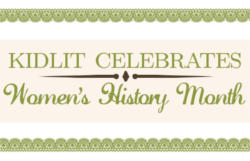
 Dianne Ochiltree has been writing stories and poems since she was a child growing up in a small Midwestern town. Today, she is a nationally recognized author of books for the very young. Her picture book, LULL-A-BYE, LITTLE ONE has been a selection for the Dollywood Fourndation’s national literacy program, and her picture book, MOLLY BY GOLLY! The Legend of Molly Williams, America’s First Female Firefighter received the Florida Book Awards Bronze Medal in the Children’s Literature category in 2012. Her earlier books have been translated into foreign language and Braille editions as well as audio versions. For more information about Dianne and her books, go to
Dianne Ochiltree has been writing stories and poems since she was a child growing up in a small Midwestern town. Today, she is a nationally recognized author of books for the very young. Her picture book, LULL-A-BYE, LITTLE ONE has been a selection for the Dollywood Fourndation’s national literacy program, and her picture book, MOLLY BY GOLLY! The Legend of Molly Williams, America’s First Female Firefighter received the Florida Book Awards Bronze Medal in the Children’s Literature category in 2012. Her earlier books have been translated into foreign language and Braille editions as well as audio versions. For more information about Dianne and her books, go to  Her books have appeared on several recommended reading lists nationwide, including the Bank Street College Children’s Book Committee ‘year’s best’, and the Dollywood Foundation’s national childhood literacy program, ‘imagination library’.
Her books have appeared on several recommended reading lists nationwide, including the Bank Street College Children’s Book Committee ‘year’s best’, and the Dollywood Foundation’s national childhood literacy program, ‘imagination library’.
![By In Helmolt, H.F., ed. History of the World. New York: Dodd, Mead and Company, 1902. Author unknown, but the portrait has several centuries [Public domain or Public domain], via Wikimedia Commons](https://upload.wikimedia.org/wikipedia/commons/2/2a/Hw-shakespeare.png)







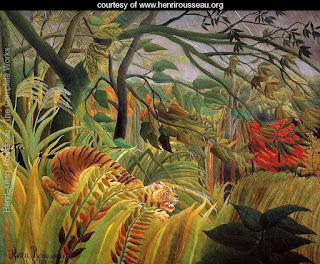









Thsi is definitely a good thing to keep in mind, I think. It’s not easy getting to that place where we feel confident in our own judgement, and even then…
It’s amazing how, even with all the research, craft improvement, etc. it can still feel like a crap shoot. We need others’ opinions, definitely have to learn our craft, but still have to try to trust our judgement with all those things taken into consideration.
I feel like I constantly walk the line between self-doubt and the urgency to send something off. I recently joined a writing critique group and I think it will help tremendously. Thanks for the post.
Just the kick in the pants I needed. I have several pieces that need to go out. Fear of rejection is a terrible thing. Of course, no one can reject my work if I don’t send it out. That has kept much of my work in a drawer. More submissions will be my new year’s resolution. Thanks for this post.
Thanks for this timely post, Bebe and Kathy. I really struggle with self-doubt. This is encouraging advice.
Nike was right with their slogan of “just do it.” :} I think all writers and artists suffer from insecurity. Every rejection, bad feedback, or no response throws us into a depressive tizzy.
Hey Kathy! Hoping the holidays have been fun for you. Thank you for this boost. I’m notorious for doubting my ability to write a good book. Maybe because I still have so much to learn. But we all must take a risk at some point and it is comforting to know that we have friends like you who have so much faith in us. Lots of hugs,